Darrel Nelson, “Southern Alberta: The Ongoing Mission,” in Canadian Mormons: History of the Church of Jesus Christ of Latter-Day Saints in Canada, ed. Roy A. and Carma T. Prete (Provo, UT: Religious Studies Center; Salt Lake City: Deseret Book, 2017), 210-241.

Darrel Nelson, a resident of Raymond, Alberta, is a retired schoolteacher with thirty-seven years of experience. His teaching career spanned five years at the high school level, teaching English, and thirty-two years at the elementary school level, teaching all subjects. He has written articles, plays, and music and is a successful novelist, with three highly acclaimed titles, The Anniversary Waltz, The Return of Cassandra Todd, and Following Rain. He served a two-year mission to Japan in 1970–71, has served as a bishop, taught early-morning seminary, and served as a temple worker. He and his wife, Marsha Smith, are currently serving as full-time self-reliance service missionaries. The couple are the parents of four children and grandparents of ten. (Darrel Nelson)
 The Cardston settlement, which began in 1887, followed by settlers who came to take up irrigated lands, formed the core of the Latter-day Saint community in southern Alberta.[1] But the agricultural base soon proved inadequate to maintain the burgeoning population. Successive waves of Latter-day Saints migrated northward to cities which later formed stakes, Lethbridge (1921), Calgary (1953), and Edmonton (1960), while others migrated further north and to other major Canadian cities. Southern Alberta has nonetheless remained a strong and vibrant part of the Church in Canada. In 1923, the Cardston Alberta Temple was dedicated and became the spiritual focal point for the southern Alberta settlement. With three stakes at that time, the southern Alberta Latter-day Saint community had grown to ten stakes by 2015.
The Cardston settlement, which began in 1887, followed by settlers who came to take up irrigated lands, formed the core of the Latter-day Saint community in southern Alberta.[1] But the agricultural base soon proved inadequate to maintain the burgeoning population. Successive waves of Latter-day Saints migrated northward to cities which later formed stakes, Lethbridge (1921), Calgary (1953), and Edmonton (1960), while others migrated further north and to other major Canadian cities. Southern Alberta has nonetheless remained a strong and vibrant part of the Church in Canada. In 1923, the Cardston Alberta Temple was dedicated and became the spiritual focal point for the southern Alberta settlement. With three stakes at that time, the southern Alberta Latter-day Saint community had grown to ten stakes by 2015.
The blessings of having a temple in southern Alberta for nearly a century are simply incalculable. From the moment it became operational in August 1923, the Alberta Temple has stood as the great symbol of local Latter-day Saint membership. It remains a divine constant amid ever-changing physical and social circumstances, the anchor of faith for Saints living in the area.
Commenting on the temple’s significance at the time of its dedication, C. Frank Steele, a Church member and writer for the Lethbridge Herald, eulogized the early Mormon pioneers of southern Alberta: “Here was a crowning reward for their faithfulness, a symbol of permanency in their new Canadian home, an evidence surest of all, perhaps, that this was destined to be a favored gathering place for the Saints. . . . The Temple brought unity to the Saints and fortified them for trials.”[2]
From the vantage point of hindsight, the blessings have become increasingly apparent. When Henry B. Eyring, then a member of the Quorum of the Twelve, visited Raymond in October 2000, Terrence C. Smith, president of the Raymond Alberta Stake, reported:
“During his visit [Elder Eyring] was very interested in the depth and commitment of the Church here in southern Alberta. He made a contrast with the Mormon settlements in northern Mexico where some of his family had lived. These settlements were both founded at about the same time by people leaving Utah and surrounding states over the conflict with the US federal government and polygamy. He noted that we had had a temple here in Canada in the vicinity for about seventy-five years at that time, while the temple in Colonia Juarez had been dedicated only the previous year in 1999. We talked at length about the effect of the presence of a temple in the creation of a strong multigenerational church community.”[3]
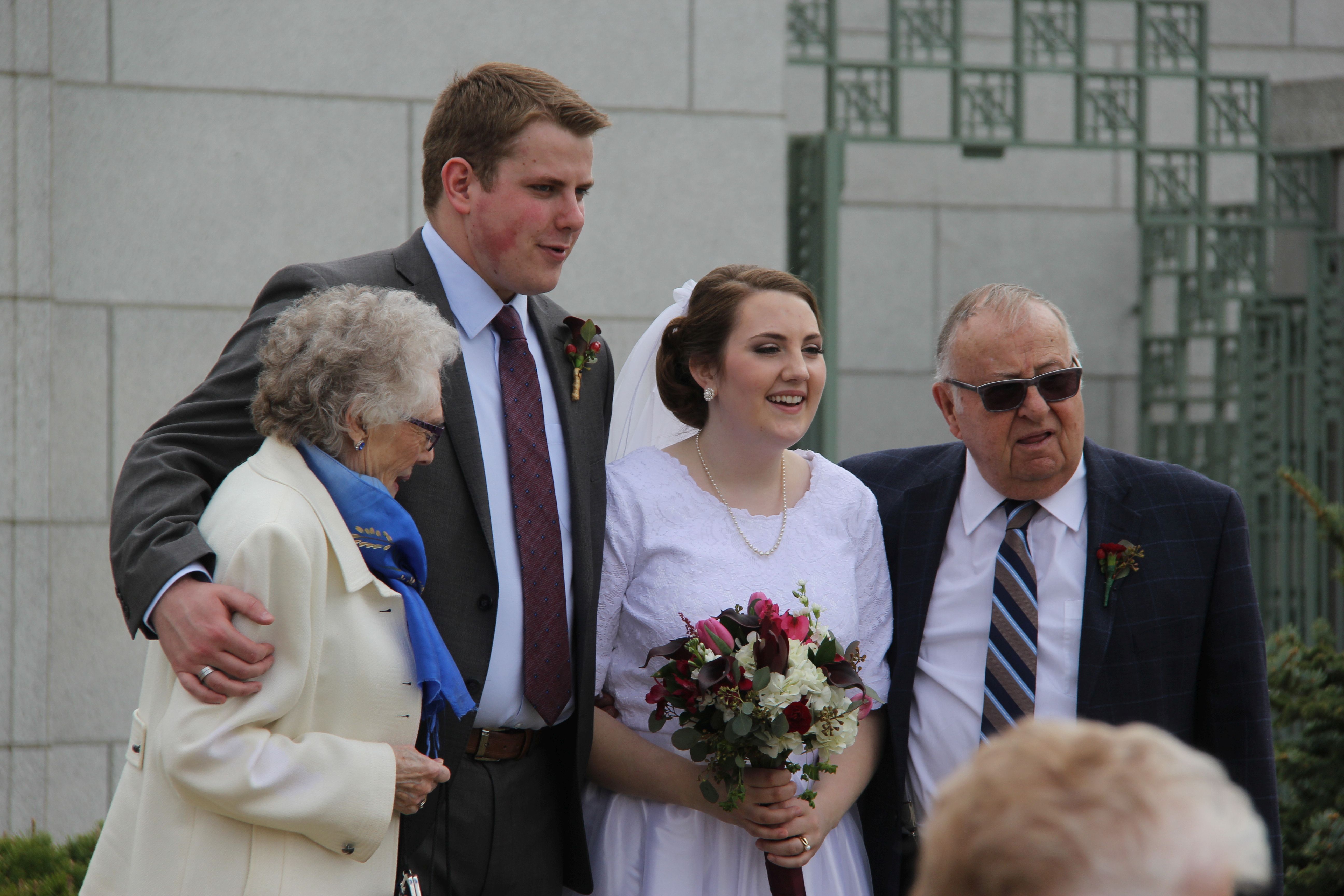 A radiant bride and handsome groom (Emily and Ben Roberts) at the Cardston Alberta Temple, enjoying a happy moment with the bride’s grandparents (William and Margaret Drew). The temple, which was dedicated in 1923, has been the spiritual focus of the southern Alberta settlement. Sacred temple ordinances, with the promise of eternal family relationships, have been an ongoing source of strength to the Latter-day Saints in southern Alberta. (Tom Matkin)
A radiant bride and handsome groom (Emily and Ben Roberts) at the Cardston Alberta Temple, enjoying a happy moment with the bride’s grandparents (William and Margaret Drew). The temple, which was dedicated in 1923, has been the spiritual focus of the southern Alberta settlement. Sacred temple ordinances, with the promise of eternal family relationships, have been an ongoing source of strength to the Latter-day Saints in southern Alberta. (Tom Matkin)
The concept of a “strong multigenerational church community” is the subject of this chapter. It examines the growth and development of the Church in southern Alberta in the postsettlement period since the dedication of the Cardston Alberta Temple. This chapter also examines the economic and world conditions that have had an impact on the Church in the region and identifies how the Saints have been blessed spiritually and fortified for their trials by having a temple in their midst. This southern Albertan nucleus of strength has been the seedbed for the growth of the Church in Canada, from the original settlements to the establishment of stakes, missions, and temples across the entire country.
Southern Alberta Church in the 1920s and 1930s
Trials and challenges were a part of life during the early years of colonization in southern Alberta and throughout the 1920s and 1930s. At the same time, it should be remembered that the history of the Church in southern Alberta is integrated with that of the larger population, as Latter-day Saints have been the core members of several southern Alberta communities.
An Arid Region
One daunting challenge was the ongoing efforts to quench the thirst of the region’s semiarid soil, made even drier by the warm Chinook winds that frequent the area. As indicated in the Alberta settlement chapter, the Palliser Triangle, in which the Saints settled, was deemed too arid for agriculture. One of the major contributions of Mormons in Canada was the introduction of irrigation into that region to make it a rich agricultural land.[4]
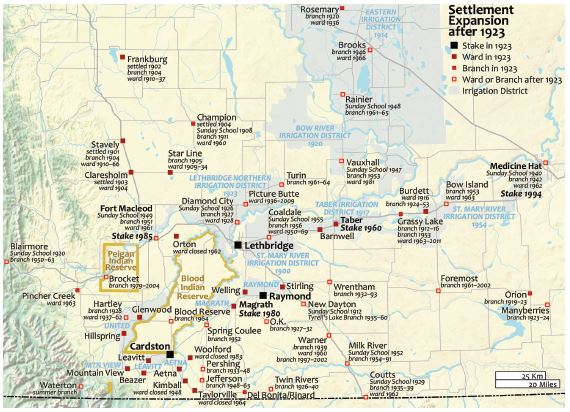 From humble beginnings more than a century ago, when Mormons experimented with irrigation in the Cardston area, irrigation projects had expanded by 2015 to service more than six hundred thousand productive hectares (nearly one and a half million acres) of Alberta land, mostly within the thirteen irrigation districts in southern Alberta.
From humble beginnings more than a century ago, when Mormons experimented with irrigation in the Cardston area, irrigation projects had expanded by 2015 to service more than six hundred thousand productive hectares (nearly one and a half million acres) of Alberta land, mostly within the thirteen irrigation districts in southern Alberta.
The extension of irrigation, as shown in the map, continued through the 1920s and 1930s under the auspices of local irrigation districts. In 1914, the government of Alberta passed legislation allowing the formation of a local cooperative to organize irrigation districts.[5] Originally belonging to the Galts and then to the Canadian Pacific Railway, the irrigation systems were expanded as local farmers banded together, purchased the systems from the railway company, and developed and adapted them to meet their needs.[6] For example, the Southern Irrigation District, established in 1919, was divided to create the Magrath Irrigation District in 1922 and the Raymond Irrigation District in 1924. As additional canal systems continued to network across southern Alberta, the number of irrigation districts increased to eight by the end of 1936. This allowed hundreds of thousands of additional hectares of land to become productive.[7]
Although the land was irrigated, the system depended on river flow, which was often low late in the growing season—so even irrigated lands were often short of water. That is why reservoirs were created later, to guarantee the supply of water in drier years. The St. Mary, Jensen, and Milk River Ridge Reservoirs were all built in the early 1950s with funding from senior levels of government.[8] In this way irrigation opened up southern Alberta to settlement and allowed the Church to flourish in the wilderness. In 2016 there were thirteen irrigation districts in southern Alberta supplying water to approximately a half million hectares of land. In addition, there were many private irrigation projects, which supplied water to another hundred thousand hectares.[9]
As Latter-day Saint farmers moved northward from the original settlements in the early twentieth century, they established settlements in many southern Alberta locations. Some settlements were made on lands serviced by irrigation districts, while some farmers opted for nonirrigated lands (see map above). The prolonged drought during the Great Depression of the 1930s caused several of the dry-farm communities to disappear, including Frankburg and Starline, while those in irrigation districts survived.
The extension of irrigation and other settlements in the 1920s and 1930s resulted in the creation of additional wards and branches in the three local stakes of Zion—Alberta, Taylor, and Lethbridge. For example, the Hartley and Pershing Branches were formed in the Alberta Stake in 1928 and 1933 respectively. The Taylor Stake increased with the creation of the Magrath Second Ward in 1922, the Wrentham Branch in 1932, the Tyrrell’s Lake Branch in 1935, and the Warner Branch in 1939. And the Lethbridge Stake expanded with the addition of the Diamond City Branch in 1928 and the Picture Butte Branch in 1936.[10]
Initially, LDS settlers preferred to be centralized into farming villages so they could attend meetings and participate in the LDS community. The introduction of the automobile in the first decades of the twentieth century, however, allowed LDS farmers to live on their homesteads but travel into towns to participate in the programs of the Church. Predominately LDS communities such as Barnwell, Taber, and Rosemary grew as LDS members continued to disperse as new irrigation systems opened up additional farmland around southern Alberta. Expanding the irrigation systems to meet the influx of settlers was a major ongoing effort, and those who did not have land under irrigation were at the mercy of nature’s demanding and fickle disposition.
During the early 1920s, several exceptionally dry years followed one another in succession. Many of the Saints in southern Alberta were discouraged, and some returned to the United States. Melvin J. Ballard of the Quorum of the Twelve Apostles visited the Taylor Stake conference in May 1922, where he counselled the Saints to plant all the grain they could but not to go into debt to do it. According to one account, “Through the power of the Priesthood, he blessed the elements for our good and rebuked the power of the destroyer. The crops were sown and it was still dry. On 28 June it started to rain and it continued to rain. The crops matured, the harvest was ideal and the frosts were stayed. As a result this part of the country where our people are located garnered the best crop since 1916.”[11]
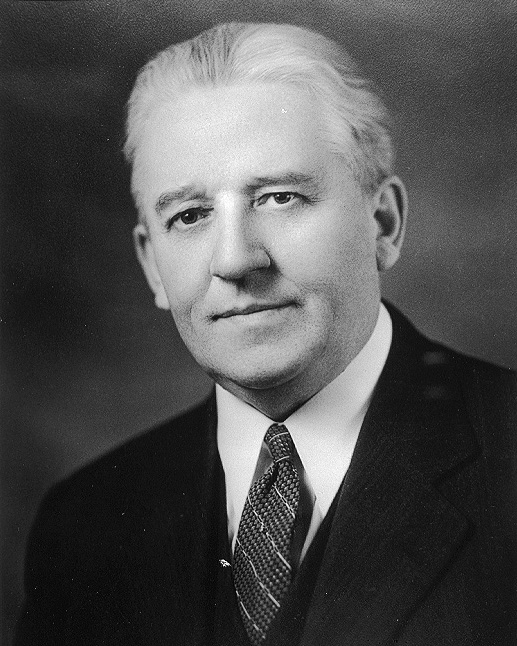 Melvin J. Ballard, ordained an Apostle in 1919, pronounced an apostolic blessing on southern Alberta during his visit to the Taylor Stake in 1922, during a period of drought. The promised blessings were realized when rains came and the farmers reaped the best harvest they had had in six years. (Intellectual reserve, Inc. [hereafter IRI])
Melvin J. Ballard, ordained an Apostle in 1919, pronounced an apostolic blessing on southern Alberta during his visit to the Taylor Stake in 1922, during a period of drought. The promised blessings were realized when rains came and the farmers reaped the best harvest they had had in six years. (Intellectual reserve, Inc. [hereafter IRI])
This pattern would repeat itself many times in southern Alberta over the years. In the spring of 2002, Elder Jeffrey R. Holland of the Quorum of the Twelve visited the Fort Macleod Alberta Stake and counselled the Saints in that area to go ahead and plant their crops. The area was experiencing a prolonged drought, and the ground was parched. The Saints had been wondering what to do. Elder Holland promised them that if they would keep close to the Lord, take care of their families, attend the temple regularly, and keep the commandments, the rains would come. He then left an apostolic blessing upon the area. The Saints heeded his advice and planted their crops. Not only did the rains arrive as promised but they came so dramatically that some local members jokingly commented that next time maybe they should get a less powerful person to pray for them! As of 2014, the area had not experienced drought since, and there had always been adequate rain to ensure a good harvest.[12]
Growth Reflected in New Stakes
The arithmetic of the Church has always been multiplication by division. Stakes and wards increase in number as growth occurs and units are divided. Following this pattern, the Church continued to spread throughout southern Alberta because of natural increase, missionary work, and immigration.
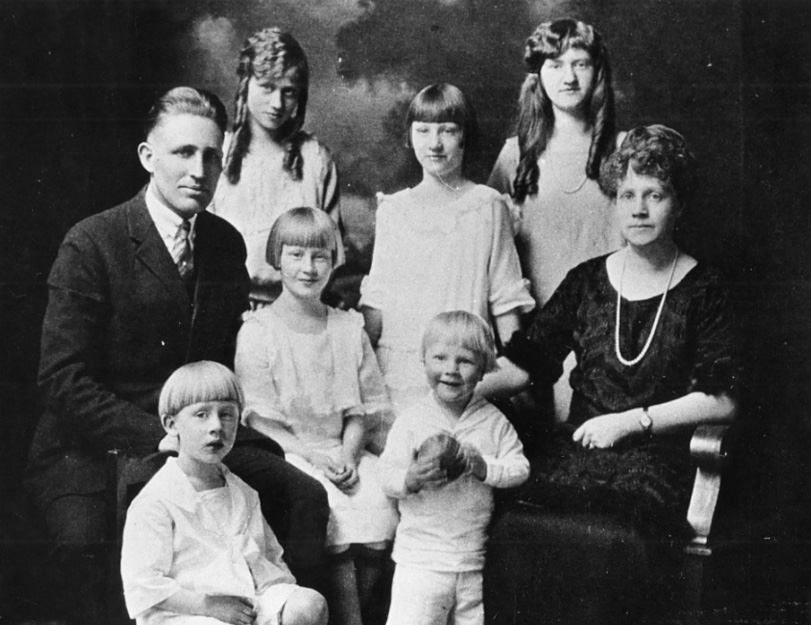 Hugh B. Brown, an attorney in Lethbridge, was called as the first president of the Lethbridge Stake in 1921. He is shown here with his wife, Zina, and their young family in 1923. Brown would later become an Apostle and a member of the First Presidency. (IRI)
Hugh B. Brown, an attorney in Lethbridge, was called as the first president of the Lethbridge Stake in 1921. He is shown here with his wife, Zina, and their young family in 1923. Brown would later become an Apostle and a member of the First Presidency. (IRI)
Stake boundaries, therefore, had to be flexible, changing as units were added, transferred, or dissolved altogether. A snapshot of the Church in southern Alberta during the 1920s and ‘30s reveals that many LDS settlers had moved northward, some to drylands and some to areas newly brought under irrigation. The widening circle of Latter-day Saint farming communities (mainly as a result of expanding irrigation), the reintroduction of the sugar beet industry, and the use of better farming practices resulted in a widespread network of wards and branches. But from the creation of the Lethbridge Stake in 1921, it was thirty years before another stake was created in Alberta—the East Lethbridge Stake. The uncertainty of the economics of the 1930s, plus World War II, probably made the Church hesitant to proceed.
Although the original Alberta Stake had at one time covered the entire province of Alberta, by 1933 its boundaries had shrunk to include only the fifteen units in Cardston and the surrounding communities. By that date, the Taylor Stake, founded in 1903, consisted of seven units, from Magrath in the west to Warner in the southeast. By 1933, the Lethbridge Stake, formed in 1921, comprised seventeen units scattered from Fort Macleod to Calgary to Rosemary to Medicine Hat. There were also Church members living in Pincher Creek and at the Crowsnest Pass during this era, but they were not part of the Lethbridge Stake at that time.[13]
Urbanization
In 1930, two-thirds of the population of Alberta was classified as rural and one-third as urban. By 1970, this proportion had more than reversed itself. Eighty percent of the population was classified as urban and 20 percent as rural.[14] There were multiple causes.
Improvements in transportation resulted in the redistribution of population. The history of transportation in southern Alberta is not only the history of economic growth and development but also of technology. In the early years, the speed of transportation, whether by foot or by wagon, averaged two to three miles per hour. This resulted in communities and grain elevators being spaced along the railway from eight to ten miles apart to facilitate travel between them. Improvements in transportation, from horse and buggy to Model Ts and trucks, affected lifestyles dramatically. As transportation improved and hard-surfaced roads were introduced, the need for a tight network of local communities disappeared. The result was a great increase in urban development.[15] In the ensuing decades, smaller communities were frequently bypassed in favour of larger centres, and this had a significant impact on the Church as well as small-town businesses. For example, when the highway from Cardston to Lethbridge was paved, local industries in Magrath, such as the Woolen Mill and the Alberta Canning Company, were drastically affected and eventually had to close their doors.[16] Lethbridge, a railway centre, which had coal mines and was the distribution centre for southern Alberta, even before the arrival of the Card settlement in 1887, took on new life as a focal point for the establishment of local industry.[17]
Changes occurred not only to the urban landscape but also to the rural landscape. During the 1940s, the average size of farms increased due to the rapid mechanization of agriculture, while the actual number of farms decreased. As a result, many rural villages disappeared, including Frankburg, Harrisville, and Commerce, forcing the closure or realignment of their wards and branches.[18]
Throughout the ebb and flow of these population changes, the Church membership was strengthened by faithful, long-serving leaders who worked tirelessly to promote and develop the Church in southern Alberta. One such exemplary leader was E. J. Wood, who served as president of the Alberta Stake from 1903 to 1942 and as president of the Alberta Temple from 1923 to 1948.
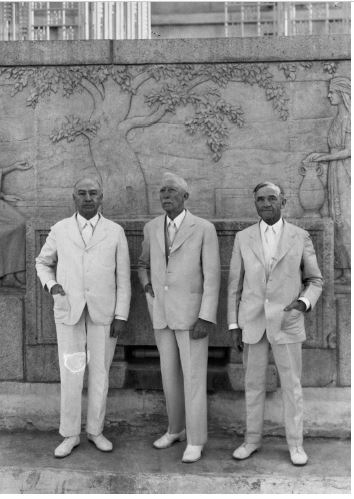 The Cardston Alberta Temple presidency in 1943. Left to right: J. Y. Card, counselor, E. J. Wood, president, and Z. W. Jacobs, counselor. (Glenbow Archives NC-7-694)
The Cardston Alberta Temple presidency in 1943. Left to right: J. Y. Card, counselor, E. J. Wood, president, and Z. W. Jacobs, counselor. (Glenbow Archives NC-7-694)
The Great Depression
The Great Depression of 1929 to 1939 created hardships in both the urban and rural areas of North America. In the urban centres of Alberta, many people lost their jobs or faced business reversals. In the rural areas, farmers faced several years of drought, hordes of grasshoppers, and excessively low prices for grain and other agricultural products.
In response to the challenges the Saints were experiencing everywhere, the First Presidency instituted the welfare program of the Church in 1936. Its purpose was to help alleviate suffering while encouraging work and self-reliance. Church members who needed assistance were expected, if possible, to work for what they received, and Saints who were better off were invited to contribute to help others.[20]
Regarding the implementation of the welfare program, Asael E. Palmer, president of the Lethbridge Stake, reported that Church members who had mortgages or debts to pay for their machinery found it “difficult or impossible to meet their obligations. A good number were unable to earn the necessities of life and could not subsist without assistance.”[21]
The Church, through the newly inaugurated welfare program, gave small loans to farmers who needed to relocate to land under irrigation. For example, eight families who moved to Rosemary were given assistance to sustain them until harvest. Most were able to repay the loans and, in turn, strengthen the Rosemary Ward.[22] In the Alberta Stake, the Church restructured mortgage contracts on the farm and ranch parcels that once had been part of the Church-owned Cochrane Ranch. This eased the burden on landowners, and most were able to honour the contracts and repay the loans. For those who defaulted on their payments, the Church honoured its business obligations to the Bank of Montreal, which held the accounts, and paid off the loans. As local historian John R. Hicken states, “Many people suffered greatly trying to balance budgets in the late 20s and throughout the Depression. And in this case, the Church eased the burden with a bail out, helping many directly and indirectly while preserving the Church’s reputation.”[23]
Assistance came in the form of inspired counsel as well as monetary aid. E. J. Wood, president of the Alberta Stake, spoke in a priesthood meeting in 1936 during the severe drought, prophesying that if the Saints were faithful, they would reap a miraculous harvest. However, the drought continued. No rains came, and warm winds blew. Many people expressed doubt in the prophecy, saying, “The President has missed it this time. He was too anxious, we are near the end; the God of Heaven has forsaken us. The crop is beyond recovery and no harvest is in the offing.” At harvest time, people had low expectations. But, to their surprise, the heads of grain were filled out, and crop yield averaged twenty bushels per acre. One witness to the event wrote, “We exclaimed, ‘The prophecy has been fulfilled! What seemed impossible has become a reality! How did it happen?’ The only analysis that seemed possible to us was that though the days were warm, the nights were cool and heavy dew fell, but no mortal had the ability to predict it. The President rose from a seeming failure to the full strength of the Lord’s divinely appointed servant, and there in the minds of most of his followers he will remain.”[24]
The Church focused on the Saints’ spiritual needs as well as their temporal needs. Temple attendance was encouraged, although it was difficult for those living outside Cardston, many of whom did not have cars, to travel to the temple regularly.[25] Occasionally, outlying wards chartered vehicles and hosted temple excursions. In Aetna, Harold Jensen, owner of the only licensed motor vehicle in the town, provided transportation to the temple every Thursday for a fee of twenty-five cents.
Throughout this period, temple patrons from Oregon and Washington, a part of the Cardston Temple district, organized a temple caravan each summer, bringing several hundred Saints at a time. The caravans continued until the Idaho Falls Temple was dedicated in 1945 and the Northwestern States Mission became part of the new temple district.[26]
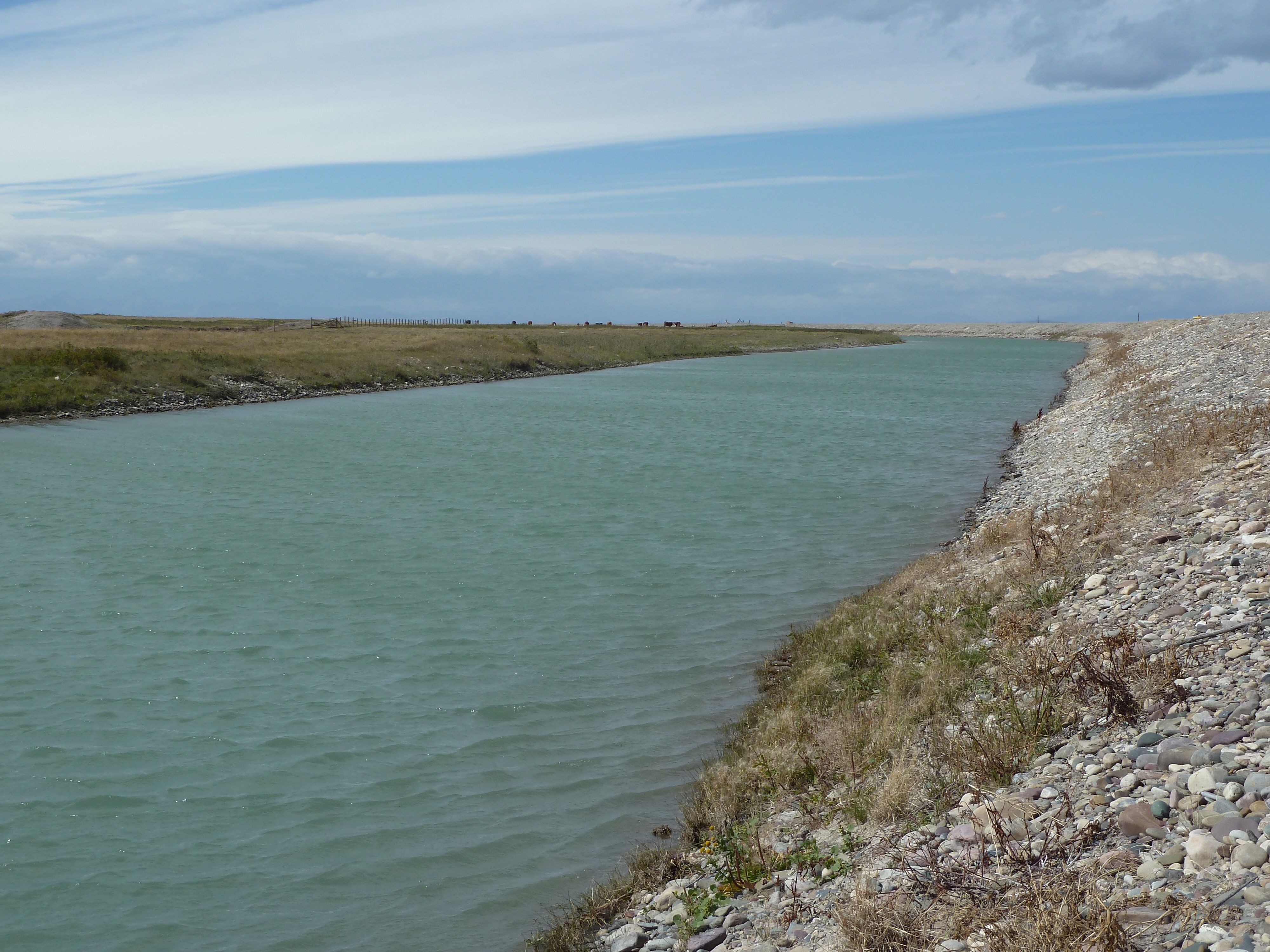
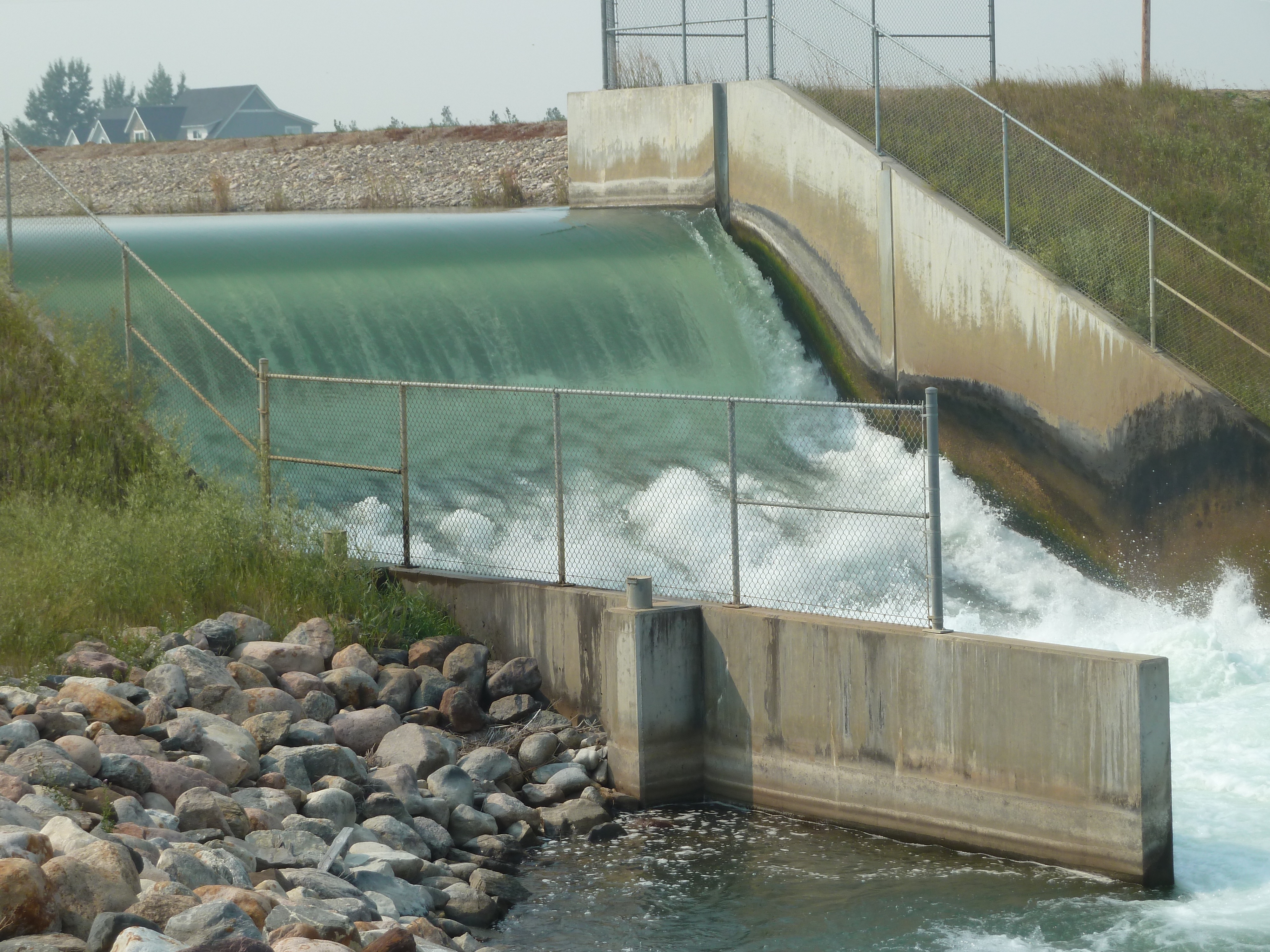 Irrigation canal and spillway near Raymond. Like arteries that carry life-sustaining fluids through the body, irrigation canals carry water—lifeblood to the arid soil—through the thirteen irrigation districts in southern Alberta. The canal systems are an integral part of the history of the region, from Magrath to Rosemary to Medicine Hat. Water is the essential resource that has allowed and continues to allow the area to thrive. (Darrel Nelson)
Irrigation canal and spillway near Raymond. Like arteries that carry life-sustaining fluids through the body, irrigation canals carry water—lifeblood to the arid soil—through the thirteen irrigation districts in southern Alberta. The canal systems are an integral part of the history of the region, from Magrath to Rosemary to Medicine Hat. Water is the essential resource that has allowed and continues to allow the area to thrive. (Darrel Nelson)
Despite the difficulties of the Depression, conditions in the irrigated areas of southern Alberta were not as bad as those in Saskatchewan and Manitoba. Because of the availability of water, the Lethbridge Stake had a bumper crop of potatoes, onions, cabbages, turnips, and other produce in 1934. Realizing how richly the Saints had been blessed, the high priests quorum inaugurated an initiative to assist the farmers of southern Saskatchewan. Under the direction of Asael Palmer, president of the Lethbridge Stake, centres were set up in each ward where members could drop off cash and produce. Because of the stake’s efforts, many non-Mormon farmers began dropping off produce at the centres as well, and the United Church of Canada, working with the Lethbridge Stake, organized the relief effort. Two boxcars of produce were shipped by rail to Regina and then redistributed to communities across southern Saskatchewan. In a humanitarian gesture reflecting the gravity of the times, officials of the Canadian Pacific Railway waived shipping charges. The boxcars, arriving just before and after Christmas, were a timely blessing, not only to members of the Church but also to others who stood in need.[27]
Although the welfare plan provided great benefits, some local wards and branches could not be saved. The struggling Starline Ward, twenty kilometres east of Claresholm, was discontinued in 1934. The Frankburg Ward, located about eighty kilometres south of Calgary, had at one time a membership of four hundred, and in 1929 it was still a thriving ward with thirty prosperous families. However, prolonged drought and low grain prices caused all but three families to lose their farms and move away. As a result, the Frankburg Ward was discontinued in 1937.[28]
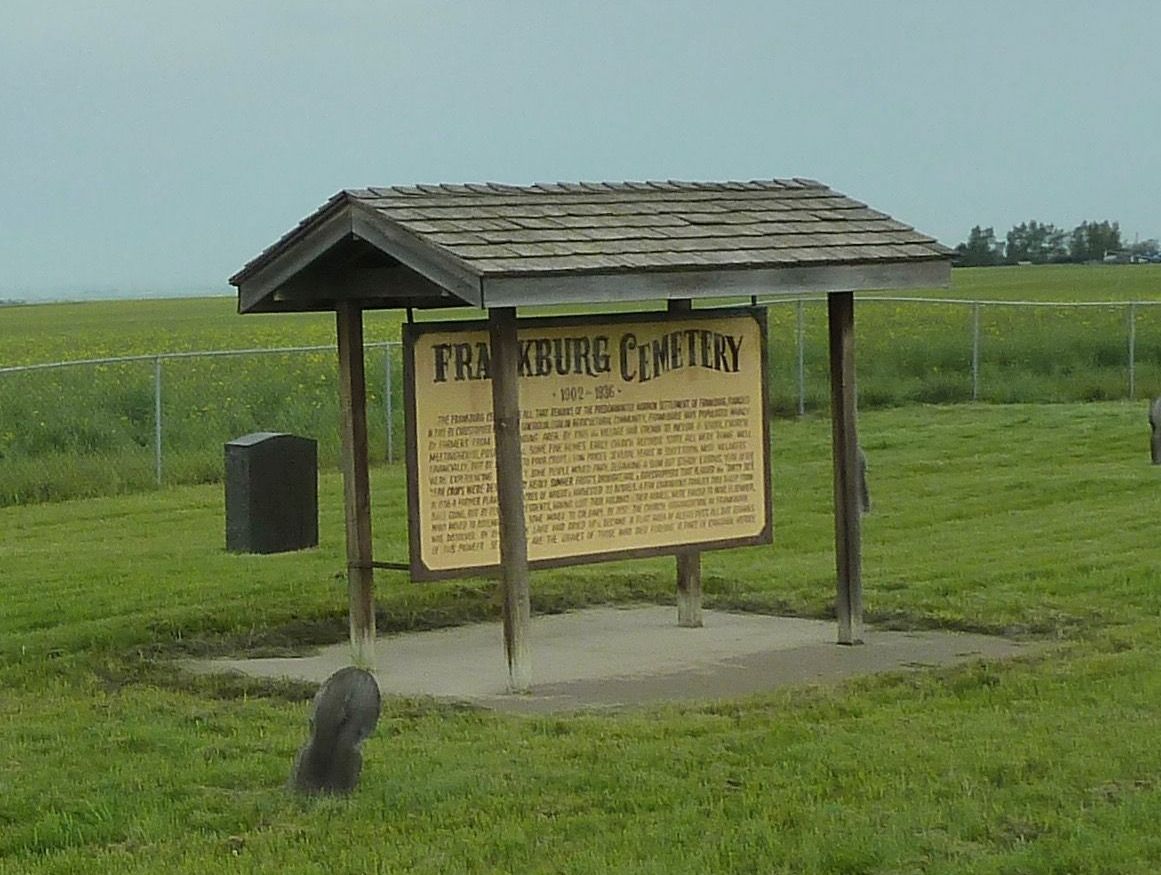 Once a flourishing community, Frankburg today consists mainly of this sign marking the cemetery. At one point the Frankburg Ward had a population of four hundred, but the years of drought in the 1930s forced most families to move away, causing the closure of the ward in 1937. (Darrel Nelson)
Once a flourishing community, Frankburg today consists mainly of this sign marking the cemetery. At one point the Frankburg Ward had a population of four hundred, but the years of drought in the 1930s forced most families to move away, causing the closure of the ward in 1937. (Darrel Nelson)
Welfare projects continued in many of the wards in southern Alberta. In 1939 in Barnwell, 160 acres of wheat were designated for welfare purposes, while in Lethbridge, Picture Butte, and Taber, land was set aside for sugar beets and other crops for welfare uses. During the 1930s, Taber began a welfare cannery for the Lethbridge Stake, with various wards and branches supplying labour during the canning seasons.[29] A major canning and food-distribution centre was developed by Church members in Lethbridge, helping to serve the needs of the entire province.[30]
Tithing was often paid “in kind” due to a scarcity of money. Members brought to the tithing house their tithes in the form of hay, grain, eggs, milk, chickens, or whatever they produced. The local bishops then dispensed the surplus.[31] It was the Lord’s way of providing for the poor and needy, and it taught the Saints to care for one another.
A touching example of care and compassion is told by Don Petrak, who as a young lad of seven moved with his non-LDS family to Raymond. The drought had taken their family farm in Saskatchewan, and so, penniless and destitute, they migrated to southern Alberta in hopes of finding the “land of promise.”
Political and Other Contributions
Members of the Church in southern Alberta continued to make their influence felt during the Depression, not only in their communities but also on the provincial level. In 1935, four Church members from southern Alberta were elected as Members of the Legislative Assembly (MLAs) when the Social Credit Party of Alberta swept to power. The party’s basic premise that all citizens had the right to the wealth they jointly produced was especially attractive to farmers who were struggling during the Depression. Based on conservative Christian and economic principles, the party appealed to the populace in general and to many Mormons in particular. And once elected, the party upheld its election promise of allowing more democratic control of the government and enacted a law restricting the sale of alcohol. The government also passed stronger labour legislation and centralized the province’s school system.[33]
Two of the Latter-day Saints from southern Alberta who were elected to the provincial legislature, N. Eldon Tanner and Solon Low, were appointed to provincial cabinet positions and moved their families to Edmonton. Tanner served seventeen years in the Legislative Assembly, first as Speaker of the House, then as Minister of Lands and Forests and Minister of Mines and Minerals. He would one day become a significant Church leader, serving as a member of the Quorum of the Twelve and the First Presidency. Solon Low became provincial treasurer under Premier William Aberhart in 1937. Seven years later, Low became the national leader of the Social Credit Association of Canada, and in 1945 he was elected to the House of Commons, where he served for thirteen years.
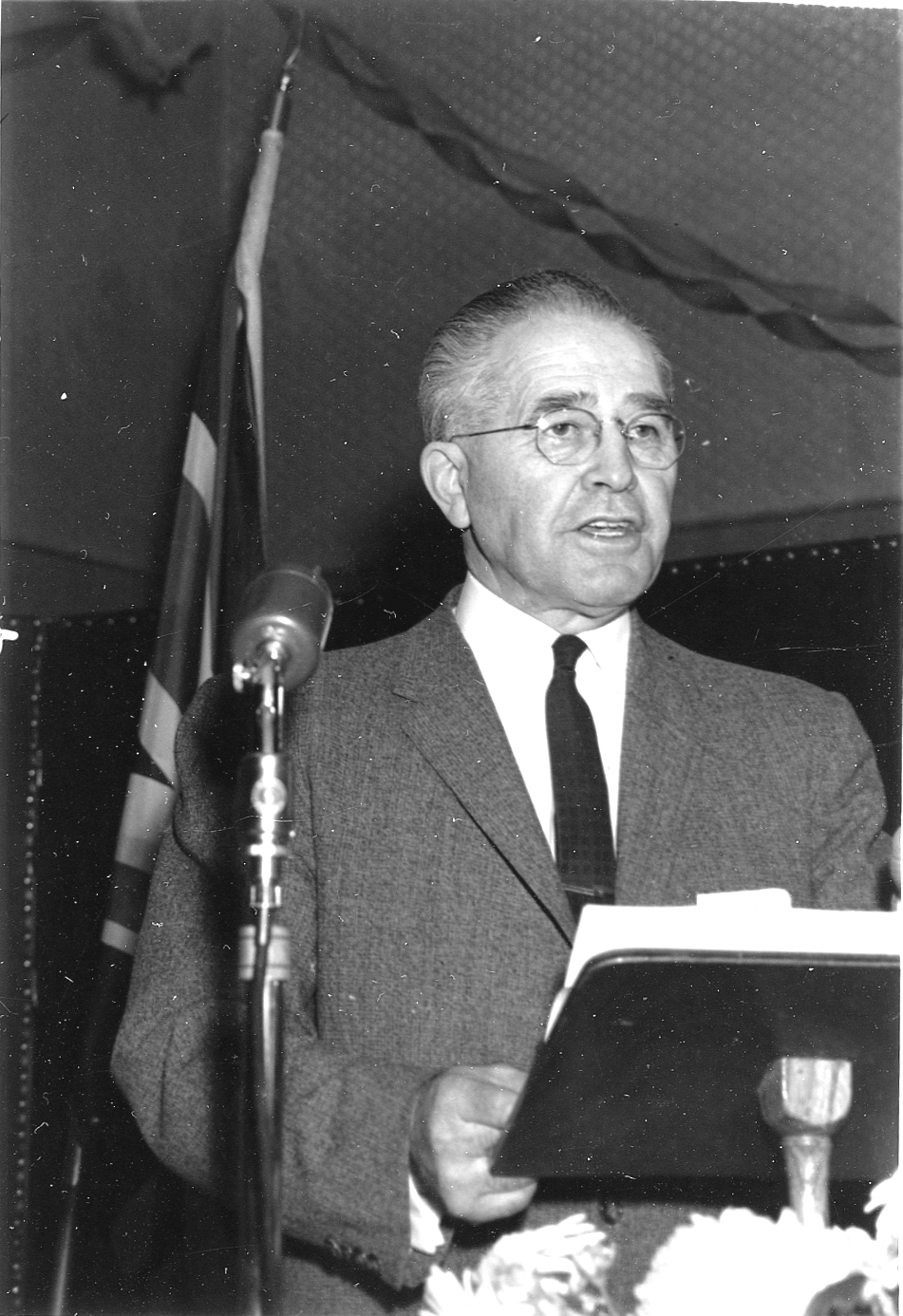 Born in Cardston in 1900, Solon Earl Low was a farmer, schoolteacher, and principal before entering politics and being elected an MLA in 1935. In 1944, he became the first national leader of the Social Credit Association, and in 1945, he was elected to the House of Commons, where he served as a Social Credit MP for thirteen years. He is one of only five members of the Church to serve as a Member of Parliament in Ottawa. (Galt Museum)
Born in Cardston in 1900, Solon Earl Low was a farmer, schoolteacher, and principal before entering politics and being elected an MLA in 1935. In 1944, he became the first national leader of the Social Credit Association, and in 1945, he was elected to the House of Commons, where he served as a Social Credit MP for thirteen years. He is one of only five members of the Church to serve as a Member of Parliament in Ottawa. (Galt Museum)
Besides service in the political arena, Church members in southern Alberta have made significant contributions in other areas as well. The influence of Asael E. Palmer on agriculture in southern Alberta is an example. His pioneer work in dry farming opened up large tracts of land otherwise regarded as unsuitable for cultivation.
In time, the Great Depression ended. The rains came, the economy rebounded, and people began picking up the pieces and trying to rebuild their lives. But before the decade was through, dark clouds appeared on the horizon once more—only these were not the clouds of dust and wind. These were the clouds of war. And once again, southern Albertans prepared to face a new adversity, one that would claim more lives, do more damage, and affect more people worldwide than any war in history.
World War II and the Postwar Era, 1939–70
On 1 September 1939, Germany invaded Poland. Two days later, France and the United Kingdom declared war on Germany, and Canada followed seven days later. The world would never be the same again.
The War Effort
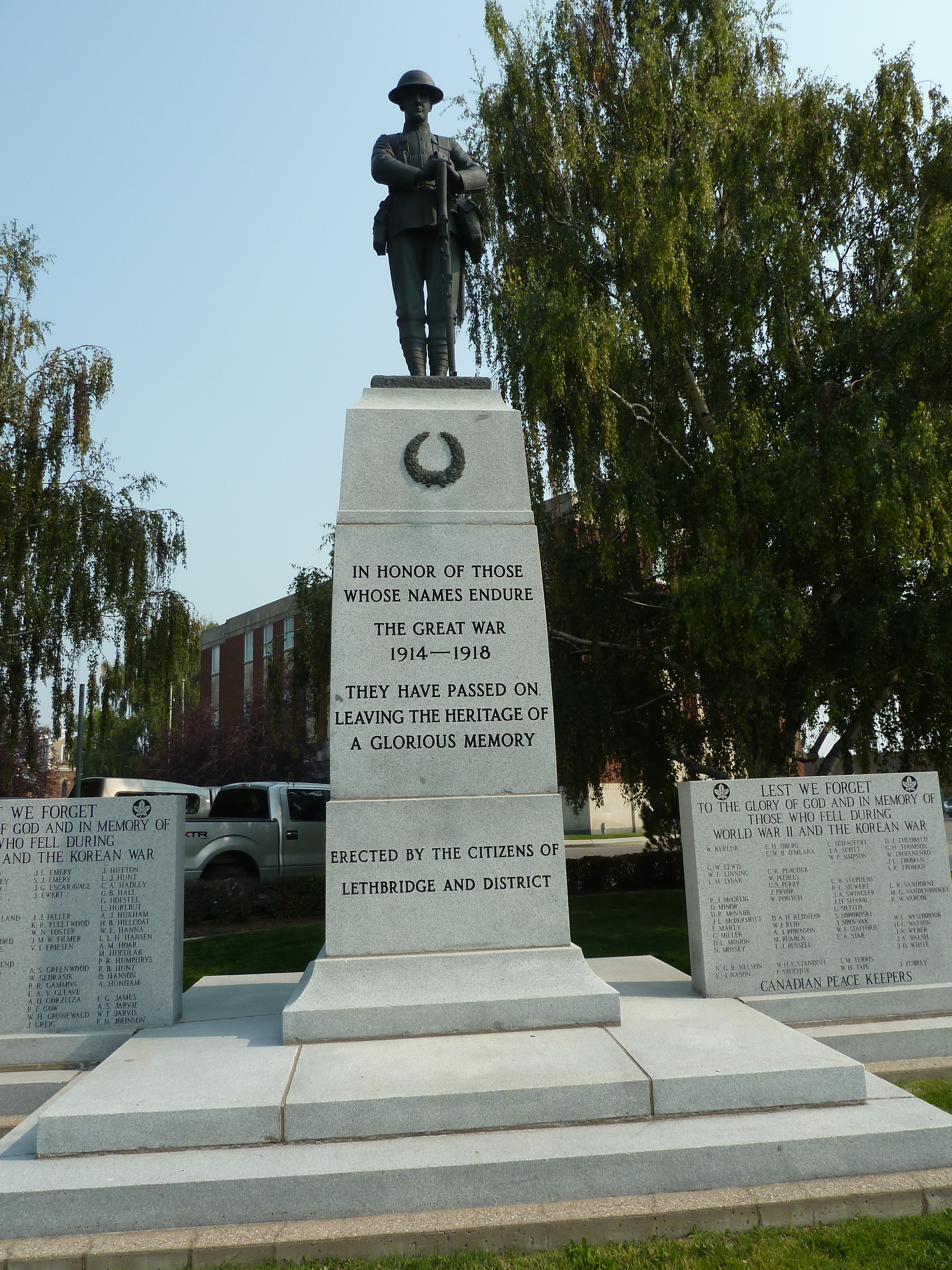 Representative of war memorials across southern Alberta, the Lethbridge War Memorial was originally constructed in memory of the 157 men from Lethbridge and the Lethbridge area who died during World War I. Built in 1931, the memorial has since been expanded to include those who fell in World War II, the Korean conflict, and as modern-day peacekeepers. (Darrel Nelson)
Representative of war memorials across southern Alberta, the Lethbridge War Memorial was originally constructed in memory of the 157 men from Lethbridge and the Lethbridge area who died during World War I. Built in 1931, the memorial has since been expanded to include those who fell in World War II, the Korean conflict, and as modern-day peacekeepers. (Darrel Nelson)
Although far from the battlefields of Europe, the communities in southern Alberta contributed significantly to the war effort during World War II. The First Artillery called up in southern Alberta included several Latter-day Saint men. And as others enlisted and the Honour Roll increased daily, the province’s enlistment rates rose to become some of the highest in Canada. In the Lethbridge Alberta Stake, some 399 served in the Armed Forces, nineteen of whom were killed in action.[36] But volunteers and enlistees came from every stake and community, and there was not a congregation in southern Alberta that was not affected by the war, especially when it involved the loss of those who paid the ultimate sacrifice.
Many of the 77,000-plus Albertans who enrolled in the armed forces lost their lives or were wounded in the defense of their country. War monuments now stand in communities across the province to honour them. But throughout the war years, there were also instances of soldiers’ lives being miraculously spared. (Please see sidebar for two soldiers’ stories.) In the words of another southern Alberta soldier, William Redd, “It would be a significant omission not to include a statement of thanks for Divine protection [during the] war.”[37]
Mormon enlistees were issued pocket-sized editions of the Book of Mormon. Owen “Brownie” Witbeck, a member of the Church who served in the infantry, said that he relied on the book being in his front shirt pocket throughout the war. He was basically the only member of the Church in his platoon, so it was a special treat to attend Church meetings or occasionally to come across other members of the Church from southern Alberta.[40]
Back at home, rationing, war coupons, blackouts, mock air raids, and many other factors affected everyone, especially the dreaded letters notifying families of the death of a loved one. The shelves in local grocery stores frequently had empty spaces as certain goods became unavailable. Church members and nonmembers alike learned to tighten their belts and adjust to the wartime conditions.[41]
Mormon communities gave full support to the war effort. Women in the local Red Cross branches donated countless hours of sewing and knitting for the men and women in the military. In 1943 in Raymond, for example, a total of 2,523 knitted items and bedding were forwarded to the Red Cross headquarters.[42]
In early 1942, the First Presidency issued a letter instructing stake leaders to reduce travel throughout the stake to save rubber, gasoline, oil, and money for the war effort. As a result, high council visits to outlying wards and branches were discontinued.[43] This increased the responsibilities of ward and branch leaders to watch over their congregations in order to meet the rising needs of those most affected by rationing and shortages of food and other necessities.
Missionary work was curtailed worldwide during World War II because so many young men were in the military. This created a serious shortage of missionaries in many areas of Canada. In response to this need, a number of short-term missionaries from southern Alberta were appointed and sent to neighbouring provinces.
 Called to serve a short-term mission in the Western States Mission, C. Lester Lybbert departed from Glenwood in the dead of winter, leaving his wife and children to milk the small herd of Guernsey cows and ship the milk to the cheese factory, as well as bake pies for the local restaurant. Difficult though the time was, the family managed and Lester returned in time to help his son, Merlin, prepare to leave on a full-time mission a few months later. (Orva Smith)
Called to serve a short-term mission in the Western States Mission, C. Lester Lybbert departed from Glenwood in the dead of winter, leaving his wife and children to milk the small herd of Guernsey cows and ship the milk to the cheese factory, as well as bake pies for the local restaurant. Difficult though the time was, the family managed and Lester returned in time to help his son, Merlin, prepare to leave on a full-time mission a few months later. (Orva Smith)
Regarding the progress of the war and Canada’s involvement in it, Bob Zobell, a member of the Church and commissioned officer in the Canadian Air Force, sent a letter home from Malta, dated May 1943. He wrote, “The end of the scrap is now in sight though it may well be a year or two, possibly more, before it is all over. If you could see all that Canada has done, and all the Canadians—well, it would make you so proud. Everywhere we are known—the English pilots who trained in Canada speak very highly of Canadian hospitality and all want to go back. So you see we all feel so glad that the people back home are all behind us 100 percent. We can’t and won’t lose. God Bless and protect you all.”[45]
A story related by Teddy A. Witbeck, a member of the Church and a dispatch rider in the Canadian Army, illustrates the kindness and generosity that sometime accompanied the harshness and deprivation of war. He said, “One time [in Holland] we were quartered in a schoolyard and a temporary kitchen was set up. We had been there for about a day or so when I spotted a little boy, maybe five or six years old, watching us eat. I walked over to the fence with my mess tin full of food. I couldn’t speak Dutch and he couldn’t speak English. So I used hand signals to ask him if he wanted some food. He understood what I was saying and nodded yes. I used my bayonet to dig a hole under the fence and passed my mess tin through the hole. He grabbed the mess tin and ran off. I figured that was the last of my mess tin. But a few minutes later he was back with my mess tin. For the remainder of the time we were there I would fill both my mess tins and give them to the little boy. I believe he took them home to feed his family. The Dutch people were literally starving at the time.”[46]
Treatment of Japanese Canadians
Members of the Church showed compassion and neighbourliness in other ways as well. In his article “The Mormons and Their Japanese Neighbours,” David B. Iwaasa wrote that “many Mormons played important roles in the Japanese-Canadians coming to southern Alberta at a time when the vast majority of other communities in Canada refused to accept them.”[47] When the Canadian government decided on a mass evacuation of all Japanese Canadians from the west coast for national security reasons, a delegation representing the Alberta Sugar Beet Growers Association—who also happened to be members of the Church—sent a proposal regarding the Japanese Canadians coming to southern Alberta to work in the sugar beet fields. This stirred up controversy because many Canadians felt it increased security threats and was nothing more than an attempt to acquire cheap labour.[48]
Some Japanese Canadians themselves were agreeable to the idea, however, because it gave them a chance to start over and remain intact as family units. Groups began arriving in southern Alberta in April 1942, and by the end of June the numbers had reached 2,250, or about 370 families. Things did not get off to a great start, however. Because previous sugar beet labourers had been of the transient nature, workers’ living quarters were poorly built and unsuitable for the harsh prairie winters. The evacuees faced other challenges as well. Water supplies and medical facilities were inadequate, and there was a lack of proximity to friends and neighbours. Work opportunities were limited, which meant the evacuees could not supplement their income to improve their standard of living. Fortunately many of these issues were resolved by 1943, when the next wave of evacuees began to arrive.[49]
 The Takeyasu family, at work in the fields topping sugar beets on their farm near Picture Butte, smile for the camera, but the work was long and hard. Acceptance and respect extended by local Latter-day Saints to the new immigrants resulted in many Japanese Canadians choosing to remain and raise their families in southern Alberta. (Galt Museum)
The Takeyasu family, at work in the fields topping sugar beets on their farm near Picture Butte, smile for the camera, but the work was long and hard. Acceptance and respect extended by local Latter-day Saints to the new immigrants resulted in many Japanese Canadians choosing to remain and raise their families in southern Alberta. (Galt Museum)
Regarding their Mormon neighbours, Iwaasa wrote, “As individuals and as neighbours living nearby, the Mormons fare quite positively. As the record clearly indicates, many individual Mormons . . . led the way in encouraging the early movement of Japanese workers into the sugar beet industry, . . . and the number of instances where prominent Mormons were asked to assist and represent the interests of the early Japanese residents (e.g. conducting marriages [and] helping with land transactions . . .) would indicate that they had the respect of the Japanese.”[50]
“With Mormons as their neighbours, many Japanese-Canadians chose to remain in southern Alberta after the conclusion of World War Two and the rescinding of discriminatory war measures.”[51] As a result of their association with local members, several Japanese Canadians joined the Church.[52]
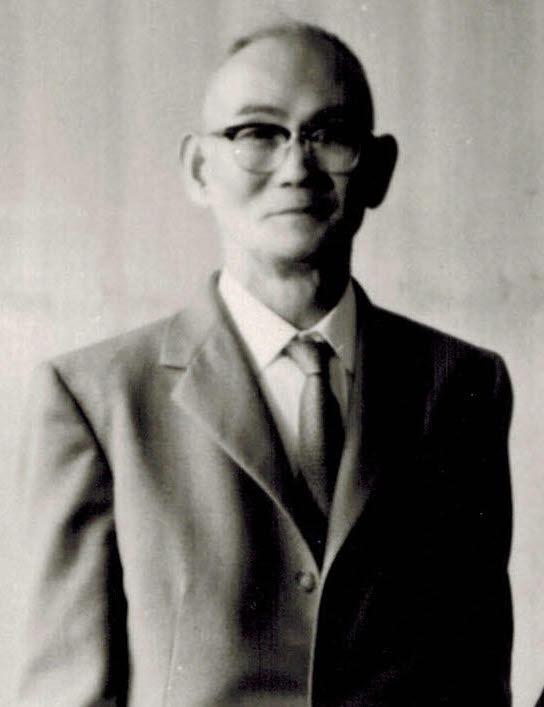 It was a long journey in the early 1900s from his native Kobe, Japan, to the community of Raymond, Alberta. Henry eventually adopted Canadian citizenship and became a farmer and landowner. His conversion to the Mormon faith was a decision that brought generations of his family into the Church. (David Iwaasa)
It was a long journey in the early 1900s from his native Kobe, Japan, to the community of Raymond, Alberta. Henry eventually adopted Canadian citizenship and became a farmer and landowner. His conversion to the Mormon faith was a decision that brought generations of his family into the Church. (David Iwaasa)
Church Growth during the War and in the Postwar Era
Despite the negatives associated with the war, it had a positive effect on the economy of southern Alberta. One stimulus was the rapid construction of airbases.[57] Communities such as Fort Macleod, Claresholm, and Vulcan were selected as Air Force training sites, and new facilities and factories had to be built quickly to accommodate the growing demands. Another stimulus was ongoing improvements in farm mechanization, which meant that fewer farm labourers were required. Both factors contributed significantly to the movement of people from rural areas to urban centres. In southern Alberta, thirty-three of thirty-five towns experienced growth from 1941 to 1951. Bow Island, Coaldale, Taber, and Nobleford all more than doubled their populations. Medicine Hat grew by more than five thousand people, and by 1953 the population of Lethbridge increased by more than 12,000 to become 26,986.[58]
The urban movement affected the Church in southern Alberta as the three stakes experienced growth, which continued even after the war ended. By 1950, Cardston and Raymond each had four wards, while Magrath, Lethbridge, and Calgary each had two.[59] Wards and branches in the smaller communities were maintained where possible, but due to a decreasing rural population, some units were dissolved. In the Alberta Stake, for example, the Jefferson Branch was amalgamated with the Taylorville Ward in 1963. The following year, the Taylorville Ward was discontinued and amalgamated with the Aetna Ward. Further changes occurred when the Aetna Ward was transferred into Cardston in 1971 but retained its name.[60]
 The presidency of the Lethbridge Stake and the high council, 1944. Front, Left to right: Francis Russell (first counselor), Asael Palmer (stake president), Reed Ellison (second counselor), and Owen Steed (stake clerk). Middle row, Left to right: William Russell, David Elton, Ivan Harris, John Johannessen, Brother Sabey, Charles Asplund. Back, Left to right: Art Green, Ted Francis, Brother Norton, Ernest Bennion, Brother Johannessen, Brother Whitehead. David Elton became the first LDS mayor of Lethbridge (1935–1943). (O. William Asplund)
The presidency of the Lethbridge Stake and the high council, 1944. Front, Left to right: Francis Russell (first counselor), Asael Palmer (stake president), Reed Ellison (second counselor), and Owen Steed (stake clerk). Middle row, Left to right: William Russell, David Elton, Ivan Harris, John Johannessen, Brother Sabey, Charles Asplund. Back, Left to right: Art Green, Ted Francis, Brother Norton, Ernest Bennion, Brother Johannessen, Brother Whitehead. David Elton became the first LDS mayor of Lethbridge (1935–1943). (O. William Asplund)
New stakes were created. The first new stake in Alberta, the Lethbridge Alberta East Stake, was created on 28 October 1951, with Grant G. Woolley as president, raising the total number of stakes in southern Alberta to four. But the stake was dissolved two years later when the Calgary Stake was organized, taking many of the northern units with it.[61] The reunited Lethbridge Stake, with Grant G. Wooley as president, now consisted of units in Lethbridge and local communities as far west as Claresholm, as far north as Champion, and as far east as Medicine Hat.[62]
Nine years later, on 11 September 1960, the Taber Alberta Stake was created, with Ray B. Evanson as president. Some wards were transferred to the newly formed stake, and units in several smaller communities were discontinued. The Taber Stake consisted of eight units from Barnwell to Medicine Hat.[63]
Growth of the Church continued in many southern Alberta communities. By the end of the 1960s there were six wards in Lethbridge, five in Cardston, four in Raymond, and two each in Magrath and Taber. Also, wards and branches spanned the length and breadth of southern Alberta from the Crowsnest Pass in the west to Medicine Hat in the east; from Rosemary and Claresholm in the north to Coutts in the south.
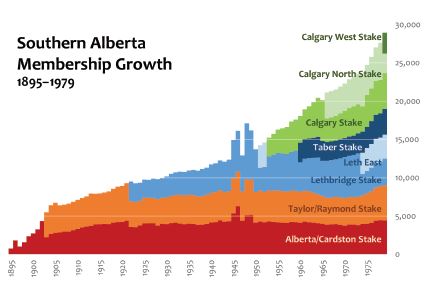 Continuing the gently upward trend of the 1920s, LDS population in southern Alberta continued to increase during the 1930s, despite some setbacks from year to year. After World War II, the larger cities in Alberta grew rapidly, and even though LDS population growth remained steady in southern Alberta, the major LDS population growth in Alberta coincided with the growth of population in the bigger cities. Note: The unusual spikes in the late 1940s are due to anomalies in the reporting system and not reflective of actual growth.
Continuing the gently upward trend of the 1920s, LDS population in southern Alberta continued to increase during the 1930s, despite some setbacks from year to year. After World War II, the larger cities in Alberta grew rapidly, and even though LDS population growth remained steady in southern Alberta, the major LDS population growth in Alberta coincided with the growth of population in the bigger cities. Note: The unusual spikes in the late 1940s are due to anomalies in the reporting system and not reflective of actual growth.
Temple Attendance and Dedication of Addition
As might be expected, attendance at the Cardston Alberta Temple improved following the war. Under the direction of the new temple president, Willard L. Smith, youth were encouraged to come to the temple by establishing a designated time for youth to “drop in” to do baptisms. The number of baptisms for the dead rose and endowment sessions were increased. In 1948, an extensive renovation plan was implemented that included improvements to the exterior and interior of the temple to facilitate the increased use.[64]
The youth program, which proved highly effective, continued in the years that followed, and youth participation remained high. As of 2015, youth were making significant contributions in family history work, including indexing, and were putting their computer and technology skills to good use. The Spirit of Elijah truly rested upon the rising generation.[65]
A new addition to the Cardston Alberta Temple was made necessary by an increase in attendance. On 2 July 1962, Hugh B. Brown of the First Presidency presided at the dedicatory service. In the dedicatory prayer he said, “We thank Thee that this great land welcomed the Latter-day Saints who came here seventy-five years ago. We thank Thee for the work that the Latter-day Saints have done in Canada, and on behalf of the Canadians we thank Thee for the contribution of the Mormon people. We thank Thee, Heavenly Father, as members of the Church for the changing attitudes of the people of this land and of the United States and all over the world toward the Church. We thank Thee that great men have been raised up in various lands to defend Thy people and proclaim the truth.”[66] Attended by over seven hundred Church members, the rededication truly was a day of celebration and reflection on the blessings of having a temple in southern Alberta.
The Southern Alberta Church, 1970–2015
The Multiplication of Stakes
The Lethbridge Alberta East Stake, originally created in 1951 but dissolved two years later when the Calgary Alberta Stake was formed, was reorganized on 24 November 1974, with Bryce C. Stringham as president. It included wards in Lethbridge and in communities as far north as Champion. In time the configuration changed, and as of 2015 the stake had eight units: four wards in Lethbridge, two in Stirling, and one each in Coaldale and Coutts. Several of the smaller rural units that used to lie within its boundaries were dissolved.[67]
The Magrath Alberta Stake was created on 26 October 1980, with James D. Bridge, a resident of Raymond, as president. This necessitated moving three wards from Raymond into the new stake to give it sufficient numbers. In that historic stake conference, Elder L. Tom Perry of the Quorum of Twelve Apostles said that he had been sent to create the Raymond East and the Raymond West Stakes but felt impressed that Magrath should have its own stake. He also indicated that it would not be many years until the three Raymond wards were returned to the Raymond Alberta Stake.[68] Seventeen years would pass before this became a reality. The Magrath Alberta Stake in 2015 consisted of seven wards in Magrath, a ward in Welling, and branches in Spring Coulee and Del Bonita.[69]
As membership continued to increase in southern Alberta, the Cardston Alberta West Stake was created on 13 November 1983, with Brent L. Nielson as president. Like Raymond and Lethbridge, this separated the community down the middle, but it was deemed necessary to accommodate and facilitate growth. The Cardston Alberta Stake in 2015 consisted of nine units: five wards in Cardston, including the Cardston YSA Ward and the Aetna Ward; with one ward each in Glenwood and Hill Spring, as well as the Kainai (Blood Nation reserve) and Lee Crest (Care Centre) Branches.[70] In 2015, the Cardston Alberta West Stake consisted of eight units: five wards in Cardston, one ward each in Leavitt and Mountain View, and a branch in Waterton Lakes Park.[71] Brian Low, president of the Cardston Alberta West Stake, indicated in 2015 that the branch in Waterton operates only from the long weekend in May to about mid-September. Yet during the peak summer months, it can have over six hundred in attendance. On those occasions the chapel and every classroom is filled, plus the sound is piped outside to accommodate the overflow.[72]
The Fort Macleod Alberta Stake was organized on 29 September 1985, with Heber J. Beazer as its first president. As of 2015, it consisted of seven units: two wards in Fort Macleod, one in Claresholm, one in Pincher Creek, and one in Park Lake Ward, plus the Pass Branch in the Crowsnest Pass.[73] The Park Lake Ward had been formed in 2009 to include the Diamond Ward and the discontinued Picture Butte Ward. The Brocket Branch in the Piikani Nation reserve had been amalgamated with the Pincher Creek Ward in 2005.[74]
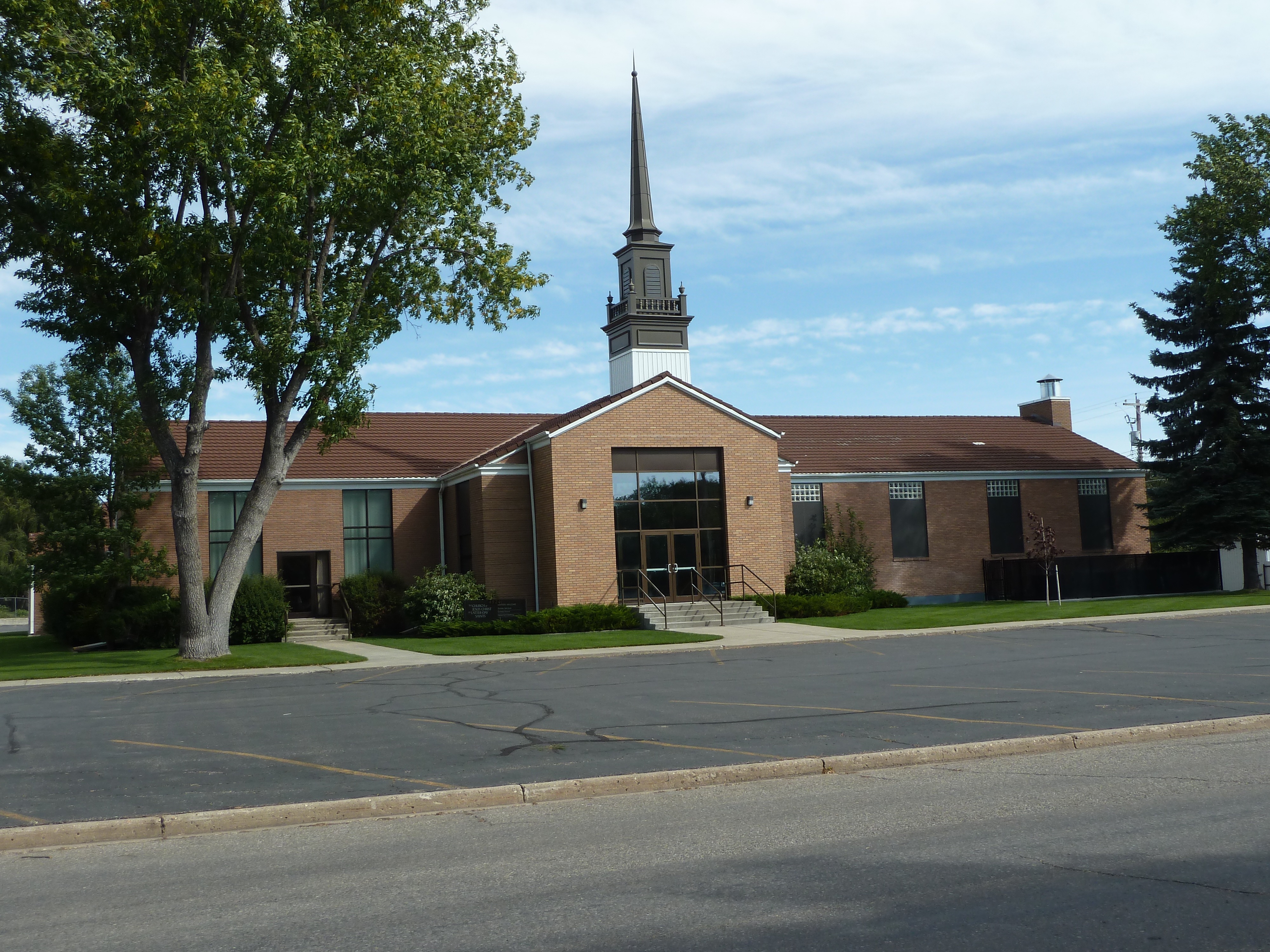 The LDS meetinghouse in Claresholm, located in the Fort Macleod Stake, was dedicated in 1980. It is typical of the three-phase buildings constructed in that period. (Darrel Nelson)
The LDS meetinghouse in Claresholm, located in the Fort Macleod Stake, was dedicated in 1980. It is typical of the three-phase buildings constructed in that period. (Darrel Nelson)
The Medicine Hat Alberta Stake was created on 20 November 1994, with Robert A. Gehmlich as president, raising the total number of stakes in southern Alberta to nine. Medicine Hat had experienced steady growth, with the creation of new wards, enabling it to become a stake on its own. As of 2015, the Medicine Hat Stake consisted of nine units: five wards and a YSA branch in Medicine Hat and one ward each in Bow Island, Brooks, and Rosemary.[75]
The creation of the tenth stake in southern Alberta, the Lethbridge Alberta West Stake, on 26 October 1997, with David P. Koegler as president, was accomplished by adjusting four existing stakes to make five. Because growth had occurred in Magrath, it had enough units to form a stake without the three Raymond wards. Accordingly, the three wards were moved back to Raymond. The Raymond Alberta Stake then consisted of the seven wards within the town, although that number would increase to nine by 2015. Stirling, Wrentham, Foremost, and Coutts were moved to the Lethbridge Alberta East Stake. The Lethbridge Alberta West Stake started out with five units but experienced rapid growth and doubled in size by 2015, when there were three young single adult wards in the stake.[76]
When Henry B. Eyring visited the Raymond Alberta Stake in October 2000, he delivered a prophecy and parting counsel that was relevant to the Saints in every community across southern Alberta. He encouraged Church members to avoid contention, to choose not to be offended by others, and to heal existing ill feelings with forgiveness and goodwill. He advised the Saints to be welcoming and loving to others in the community who were not Church members, whether or not those neighbours chose to join the Church. By maintaining friendly relationships with all, LDS members would foster an environment of positive feelings toward the Church. Although Latter-day Saints “might not always be in the majority here as we are now,” he said, “we will be benefitted if the majority of the community remains friendly toward the Church. . . . The best days are still ahead for this community. More and more people will feel the sweetness of the gospel and of associations together here.”[77]
It was remarkable to see how then-Elder Eyring’s prophecy continued to be fulfilled. “More and more people” aligned themselves with the Church, and it continued to flourish. By 2015, with ten stakes in southern Alberta, comprising seventy-nine wards and branches, the work continued.[78]
First Nations
Since the time of the Saints’ arrival in southern Alberta, the First Nations people have been regarded as “part of a dispersed Israel.”[79] Missionary work began among them soon after, but it was somewhat sporadic until 1949, when the Church began a more concerted effort. Twenty-six local missionaries were assigned to work on the Blood Nation reserve, and church meetings were held at different locations on the reservation. First Nations members were originally part of the Cardston Fourth Ward, but, as their numbers increased, the Kainai Branch was created on the reservation in 1964, with James Blackmore as branch president. The work was later placed under the auspices of stake mission presidents, and missionary labors expanded to other reservations in Alberta.[80]
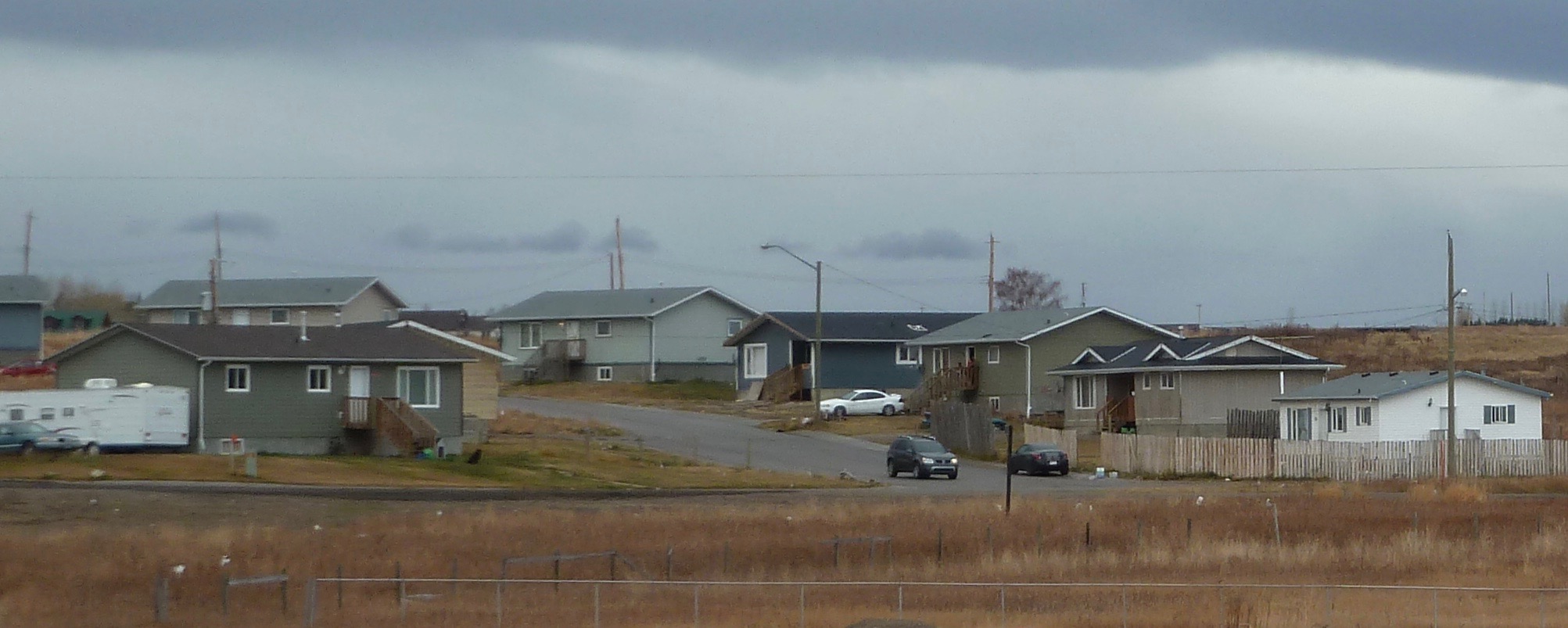 The Kainai Indian Reserve No. 148, near Cardston, is the largest reserve in Canada and the second most populous. Brent L. Lybbert, president of the Cardston Stake, expressed his belief that it was no accident that Cardston was established adjacent to the reserve. Missionary work has continued, and the Kainai Branch consisted of ninety-five members in 2015. (Darrel Nelson)
The Kainai Indian Reserve No. 148, near Cardston, is the largest reserve in Canada and the second most populous. Brent L. Lybbert, president of the Cardston Stake, expressed his belief that it was no accident that Cardston was established adjacent to the reserve. Missionary work has continued, and the Kainai Branch consisted of ninety-five members in 2015. (Darrel Nelson)
The Church gave particular emphasis to First Nations youth in the latter half of the twentieth century through the Lamanite Student Placement Program. Spencer W. Kimball, Church President from 1973 to 1985, was a strong advocate for Native Americans and, as a member of the Quorum of the Twelve, was involved in the beginning of the program in 1947, in which some Latter-day Saint First Nations youth were placed in LDS foster homes during the school year to enable them to receive a better education. The program was described as “a new awakening on the part of members of the Church to the Lamanite and his prophetic destiny.”[81] By the mid-1960s, there were about fifty youth from the Blood Tribe who had been placed in Latter-day Saint homes across Canada. The program was designed to help the students obtain a better education and to help them learn more about their LDS faith. According to a study in the US reported by James B. Allen, “The results, so far as the parents were concerned, were overwhelmingly positive: 82 percent reported a favourable effect on their families, and only 13 percent reported any negative consequences. Religiosity improved, education benefited the children, and younger siblings profited from the experiences of their older brothers and sisters. When asked if they would place their child in the program if they had it to do over again, 88 percent of the natural parents said yes.”[82] The Student Placement Program continued until 2000 and then was phased out.
Brent L. Lybbert, who became president of the Cardston Alberta Stake in 2011, indicated that the work was flowering among the local First Nations people. When he began to serve as stake president, the Kainai Branch had twenty-five active members.[83] As he contemplated closing the branch and integrating it with one of the Cardston wards, the Spirit whispered to him, “These are also my people and you must do all you can to help save them.”[84] One evening, as he was looking through Go Forward with Faith, the biography of President Gordon B. Hinckley, he came across a photograph of President and Sister Hinckley’s visit to Cardston at the time of temple rededication in June 1991. The photograph featured a member of the First Nations in full headdress, standing beside President and Sister Hinckley.[85] As President Lybbert studied the photograph, the Spirit whispered, “That is the man who is to be the next branch president.” Eventually, the man in the photograph—Garry Fox—was called as branch president, and under his strong leadership, along with that of his counselors, the Kainai Branch had grown to comprise ninety-five active members by 2015. The members were involved in doing temple work, and they had a high attendance rate. President Lybbert believed that it was not coincidence that the largest First Nations reserve in Canada is located directly beside Cardston.[86]
Renovations and Rededication of the Temple
Beginning in 1988, the Cardston Alberta Temple was closed for three years in order to undergo extensive renovations. In the interim, southern Albertan Saints attended the Idaho Falls Temple. During the long drive south, members were reminded how fortunate they were to have had a temple in their midst since 1923.[87] When at long last the renovations were completed in 1991, the temple was opened to the public. More than one hundred thousand people attended the open house, two-thirds of whom were not LDS. Eleven dedicatory services were held from 22 to 24 June with Gordon B. Hinckley and Thomas S. Monson (counselors in the First Presidency) and several Apostles and general Church officers in attendance. This was the third set of dedicatory services held at the temple in its sixty-eight-year history.[88]
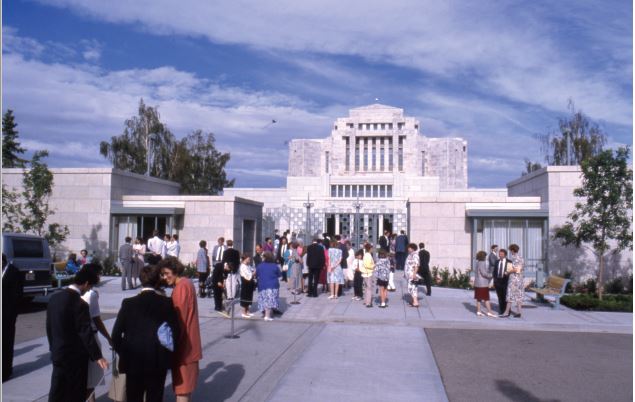 After a period of three years, when the Cardston Alberta Temple was closed for extensive renovations, an estimated twenty-five thousand Church members attended the twelve dedicatory sessions of the Cardston Alberta Temple on 22–24 June 1991.[89] (Mike Cannon, Church News)
After a period of three years, when the Cardston Alberta Temple was closed for extensive renovations, an estimated twenty-five thousand Church members attended the twelve dedicatory sessions of the Cardston Alberta Temple on 22–24 June 1991.[89] (Mike Cannon, Church News)
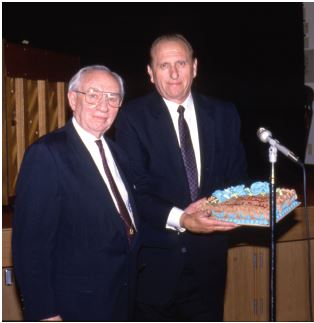 Gordon B. Hinckley and Thomas S. Monson, counselors to Church President Ezra Taft Benson, attended the dedicatory services of the Cardston Alberta Temple in June 1991. While they were in Cardston, President Hinckley celebrated his eighty-first birthday.[90] (Mike Cannon, Church News)
Gordon B. Hinckley and Thomas S. Monson, counselors to Church President Ezra Taft Benson, attended the dedicatory services of the Cardston Alberta Temple in June 1991. While they were in Cardston, President Hinckley celebrated his eighty-first birthday.[90] (Mike Cannon, Church News)
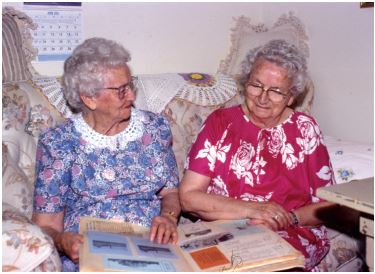 Two elderly sisters, Elizabeth Broadbent Smith (right) and Dora Broadbent Leavitt (left), attended the rededication of the Cardston Alberta Temple in June 1991. The event stirred memories, as each of the women had also attended the original dedication of that temple in 1923, when Elizabeth was twenty-three and Dora was twenty-one.[91] (Rod Gustafson, Church News)
Two elderly sisters, Elizabeth Broadbent Smith (right) and Dora Broadbent Leavitt (left), attended the rededication of the Cardston Alberta Temple in June 1991. The event stirred memories, as each of the women had also attended the original dedication of that temple in 1923, when Elizabeth was twenty-three and Dora was twenty-one.[91] (Rod Gustafson, Church News)
In September 1995 the Cardston Alberta Temple was designated an historic site. At a ceremony held at the Temple Street Chapel, Bud Olsen, a member of the Canadian Senate, unveiled a plaque and noted the temple had attained both architectural and national significance with the designation. He indicated that the designation was to “assist in the preservation of Canada’s distinctive identity and national heritage . . . and to help Canadians identify and find their roots, adding a significance to daily life.”[92] The government recognized the temple as a building of “architectural and national significance,” but to the Saints it was and continues to be much more. It is the house of the Lord, a building of eternal significance, a structure that is “the great symbol” of Church membership.[93]
Gathering
The influence of the temple continued to reach across southern Alberta, affecting lives in subtle and dramatic ways. During his visit to the Raymond Alberta Stake in 2000, Henry B. Eyring indicated that people would come to Raymond and the other neighbouring LDS communities but wouldn’t necessarily know why. Something inexplicable would draw them here.
In retrospect, it was noted that Raymond, Stirling, and Magrath had experienced growth, as increasing numbers of both LDS members and nonmembers recognized the advantages of the rich, small-town community life for raising their families. The strong community culture, lower house prices, and easy commute to Lethbridge saved these communities from declining in a time when agriculture no longer employed large numbers of people. They, in fact, have become bedroom communities of Lethbridge, which had grown to a city of ninety-three thousand by 2015.[94]
In Cardston, the pattern has been a little different, with growth more directly related to the town’s appeal as a retirement community for those wishing to serve in the temple. But it is more than housing opportunities, travel convenience, and small-town advantages that bring people to southern Alberta. Many newcomers have indicated they feel something special—often described as a spirit of peace and community—that convinces them to stay and put down roots. They are sensing, in then-Elder Eyring’s words, the “sweetness of the gospel” as the Church expands its focus of reaching out and touching lives in these challenging times.
Seminary, Institute, and Young Single Adult Wards
Religious education was important to the Saints in southern Alberta from the earliest settlement period. By 1904, religion classes were part of the public school curriculum in the Alberta Stake. By 1944, the seminary program was in operation in each high school in the Taylor Stake. Released- time seminary was introduced in Cardston and Raymond in May 1948, and by the following year, the program had expanded to Magrath, Welling, Glenwood, and Hillspring. A seminary building was erected in Lethbridge in 1957 as an early-morning facility, and released-time classes began in Taber in 1977. Home-study seminary was introduced in 1967 and online seminary in 2010.[95]
 This seminary building in Taber, dedicated in 1997, is representative of seminary buildings located in communities from Cardston to Medicine Hat. (Darrel Nelson)
This seminary building in Taber, dedicated in 1997, is representative of seminary buildings located in communities from Cardston to Medicine Hat. (Darrel Nelson)
The institute of religion program, which provided support and weekday religious instruction to students attending secular colleges and universities, began in Lethbridge in 1958.[96] In 1992, the Church launched an expanded program to include not only college and university students in the institute program but other young adults as well, directing every stake to offer at least one institute class. All single members of the LDS Church under the age of thirty-one were encouraged to attend institute where possible.[97]
The first young single adult ward in Lethbridge was created in 1969, with a second added in 1984. After the expansion of the institute program in 1992, more young single adult wards were created in southern Alberta. They served as a magnet for young people from elsewhere to gather for religious worship and social interaction. In 2015, there were six YSA wards in Lethbridge, one in Cardston, and a YSA branch in Medicine Hat.[98]
Welfare Services
 Deseret Ranches of Alberta is an example of the Church’s efforts to diversify their holdings and create safe investments for times of need. Land holds its value, and crops and livestock can be raised on it. Properties under the Deseret Ranches of Alberta include ranches that are known or have been known as the Bar K2, the Kircaldy, the Knight, the Horseshoe, Deer Haven, and recently the Taber Farms. (Darren Bevans)
Deseret Ranches of Alberta is an example of the Church’s efforts to diversify their holdings and create safe investments for times of need. Land holds its value, and crops and livestock can be raised on it. Properties under the Deseret Ranches of Alberta include ranches that are known or have been known as the Bar K2, the Kircaldy, the Knight, the Horseshoe, Deer Haven, and recently the Taber Farms. (Darren Bevans)
The Church has always had a mandate to address the temporal as well as the spiritual needs of its members. In southern Alberta, land was purchased for Church welfare farms. On these farms, volunteers planted, watered, and harvested hard red spring wheat for use throughout Canada. At harvest time, the wheat was stored in the Church-owned granary in Magrath, and when wheat was needed, volunteers bagged the wheat into twenty-five-pound bags and sent it to storehouses across Canada. Of the five bishops’ storehouses in Canada, one is located in Lethbridge, with the others in Calgary, Sherwood Park, Vancouver, and Toronto. In 2015, the Fort Macleod and Taber Stakes each had two welfare farms; and the Raymond, Magrath, and Lethbridge East stakes each had one, making seven in all. In addition to the welfare farms, the Church also owns more than a hundred thousand acres of ranchland in the area.[99]
Explaining why the Church invests in farms and ranches, President Hinckley said, “As you know, we have some welfare properties whose produce is used to supply food for the needy. These are operated strictly for charitable purposes and legally qualify for tax-exempt status. Then we have some commercial farm properties. I spoke earlier of the reserves of the Church. Prudent management requires that this money be put to use. In that process, we have purchased and hold some good, productive farms. They are well operated under capable management, and they yield a conservative rate of return. We have felt that good farms, over a long period of time, represent a safe investment where the assets of the Church may be preserved and enhanced, while at the same time they are available as an agricultural resource to feed people should there come a time of need.”[100] Darren Bevans, the manager of Deseret Ranches of Alberta, states that Church-owned ranches fall under the same guidelines and purposes as the farms, and adds that Deseret Ranches of Alberta is operating as a profitable and safe investment.[101]
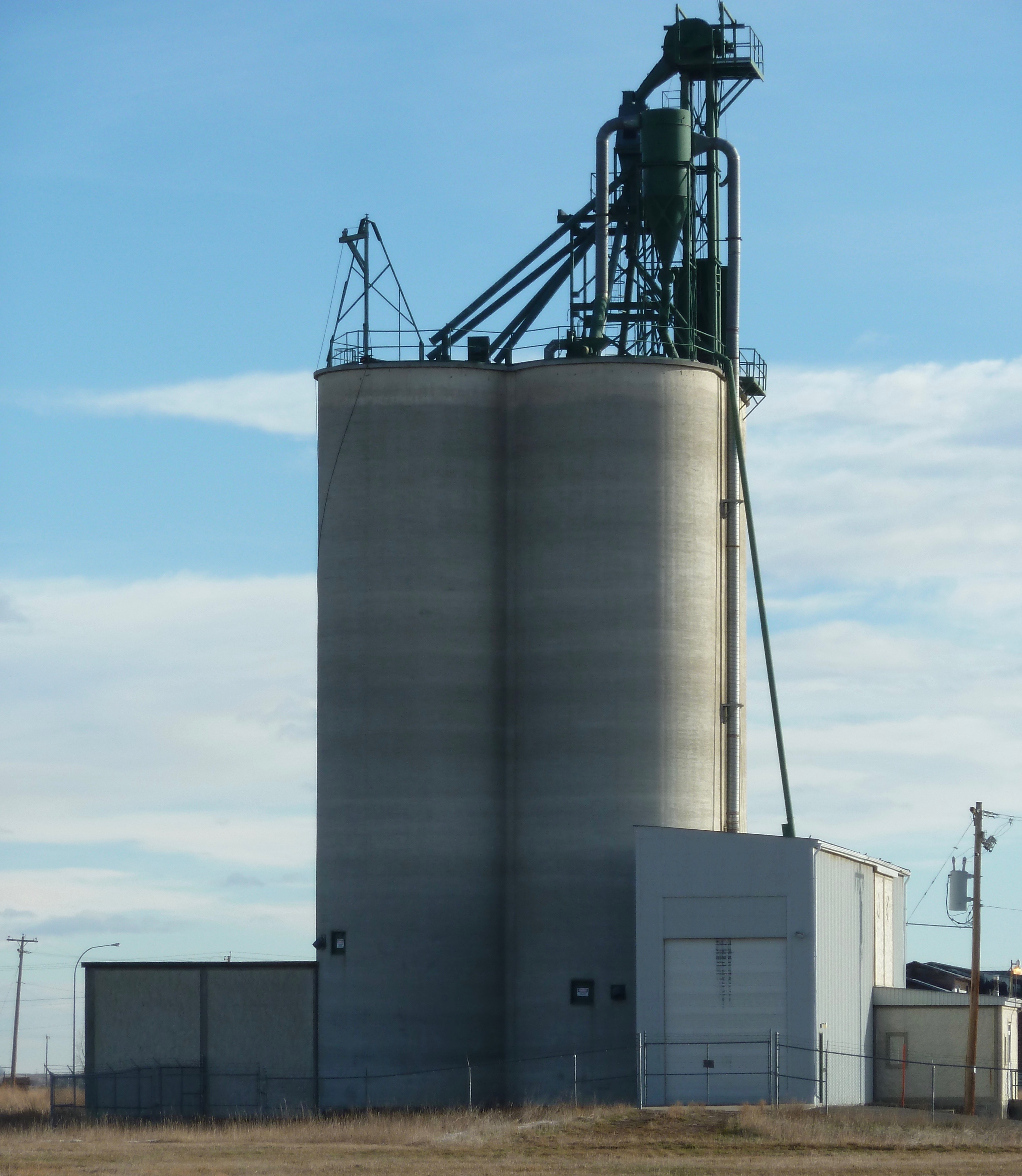 The seven designated welfare farms in southern Alberta are given production assessments each year to get grain (hard spring red wheat) to this regional granary located in Magrath. When needed, the grain is then bagged and shipped to the five welfare facilities in Canada. (Darrel Nelson)
The seven designated welfare farms in southern Alberta are given production assessments each year to get grain (hard spring red wheat) to this regional granary located in Magrath. When needed, the grain is then bagged and shipped to the five welfare facilities in Canada. (Darrel Nelson)
Over time, the welfare services of the Church expanded to include family services, adoption, mental health, employment resource centres, the addiction recovery program, and various other services, provided by trained professionals and designed to provide support and help to Church members that is consistent with gospel principles.[102] In 2015, these services were housed in the southern Alberta office, located in Lethbridge. The core services included a twenty-four-hour help line for priesthood leaders.
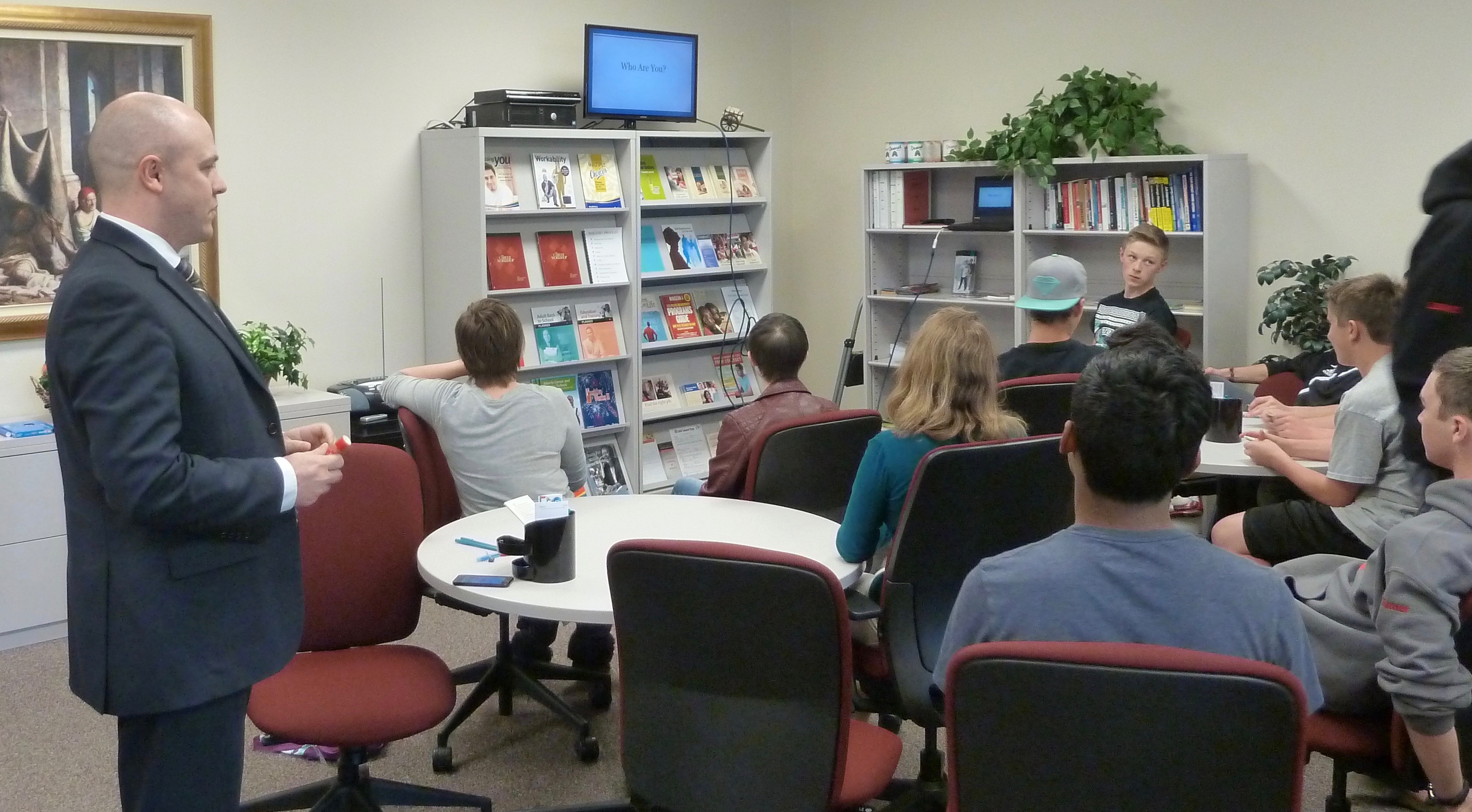 Latter-day Saint youth are being instructed in job-seeking skills by David Reeve, the manager of LDS Employment Resource Services in Lethbridge in 2016. The stated purpose of the centre is to help individuals complete résumés, learn interview skills, discover job options, and learn self-reliance. The main goal of the employment centre, Reeves said, was to ensure that individuals seeking assistance receive a sense of hope.[103] (Darrel Nelson)
Latter-day Saint youth are being instructed in job-seeking skills by David Reeve, the manager of LDS Employment Resource Services in Lethbridge in 2016. The stated purpose of the centre is to help individuals complete résumés, learn interview skills, discover job options, and learn self-reliance. The main goal of the employment centre, Reeves said, was to ensure that individuals seeking assistance receive a sense of hope.[103] (Darrel Nelson)
Leaders from Southern Alberta
Since the early years of the Cardston settlement, Latter-day Saints have held political offices in southern Alberta, with John Woolf, Martin Woolf, and George Stringham serving in succession from 1902 to 1935 as members of the Alberta legislature.[104] In 1935, the Social Credit Party swept to power in Alberta. Among those elected as Alberta MLAs were N. Eldon Tanner and Solon Low, both Latter-day Saints from southern Alberta, who served as important cabinet ministers. In the years that followed, Edgar “Ted” W. Hinman served as Minister of Municipal Affairs from 1954 to 1955 and Provincial Treasurer from 1955 to 1964,[105] Jack Ady served as Minister of Advanced Education and Technology and Career Development from 1986 to 1997,[106] and Broyce Jacobs served on various parliamentary committees from 2001 to 2004 and 2008 to 2012. Ted Hinman’s grandson, Paul Hinman, served as an MLA from 2004 to 2008, as did Gary Bikman from 2012 to 2015 and Grant Hunter in 2015.[107]
At the national level, John Blackmore and Solon Low, both from southern Alberta, were the first two Latter-day Saints to be elected as Members of Parliament in Ottawa, Blackmore from 1935 to 1958 and Low from 1945 to 1958.[108] Grant Hill, a medical doctor from Okotoks, was elected to Parliament in 1993 and served until 2004.[109] Jim Hillyer, born in Lethbridge and raised in Stirling, successfully battled leukemia and was elected to the House of Commons in 2011, where he served until his sudden death in March 2016.[110] In the realm of municipal politics, David H. Elton was the first Latter-day Saint mayor of Lethbridge, serving from 1935 to 1943.[111]
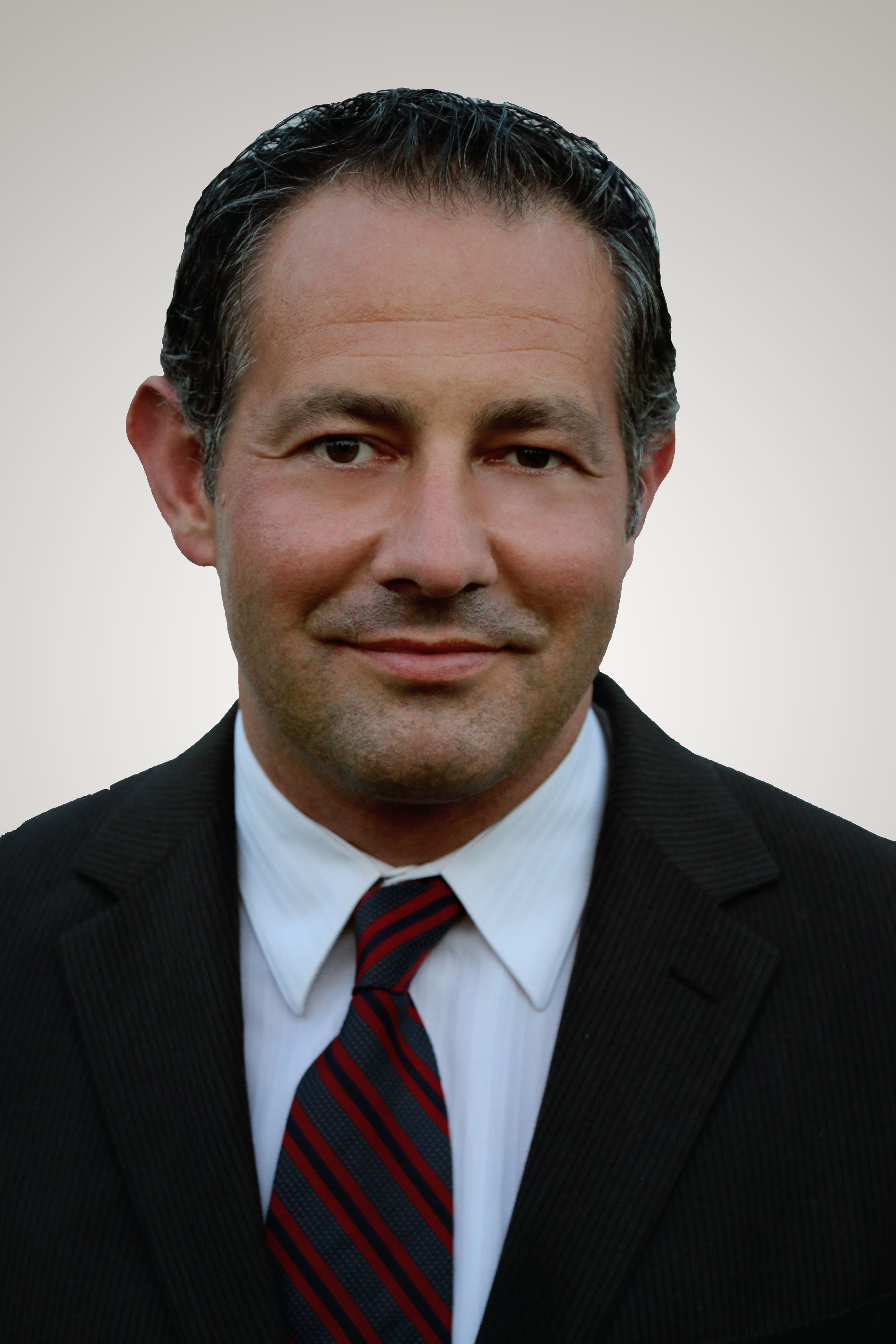 A native of Stirling, Alberta, and a returned missionary from the Canada Montreal Mission, Jim Hillyer was one of only five members of the Church in Canada to become a Member of Parliament. He was originally elected in 2011 to the House of Commons for the federal Conservative Party of Canada, representing the district of Lethbridge. In the federal election of 2015, he was reelected, but this time representing the Medicine Hat-Cardston-Warner district due to boundary changes. Hillyer died unexpectedly in March 2016, sitting at his desk in his Ottawa office. (Jim Hillyer)
A native of Stirling, Alberta, and a returned missionary from the Canada Montreal Mission, Jim Hillyer was one of only five members of the Church in Canada to become a Member of Parliament. He was originally elected in 2011 to the House of Commons for the federal Conservative Party of Canada, representing the district of Lethbridge. In the federal election of 2015, he was reelected, but this time representing the Medicine Hat-Cardston-Warner district due to boundary changes. Hillyer died unexpectedly in March 2016, sitting at his desk in his Ottawa office. (Jim Hillyer)
More than any other resource, people are southern Alberta’s greatest export. The movement of faithful Latter-day Saints from southern Alberta to other areas has contributed significantly to the growth and establishment of the Church across Canada. For example, when the Calgary and Edmonton Stakes were organized in 1953 and 1960, respectively, all of the members of the two stake presidencies and most of the high councils and other leaders came from southern Alberta.[112] Their impact has also been felt in neighbouring provinces, British Columbia and Saskatchewan, and far away as Ottawa, Toronto, and Halifax.
As demonstrated in the sidebar, the number of general Church officers who have come from southern Alberta are many more than one might expect for a community of its size.[113] This is not meant to overlook the significant contributions made by members of the Church from southern Alberta in every field of endeavor, be it politics, medicine, education, business, or culture. They too have been remarkable.
The Ongoing Mission
As the Church in southern Alberta moved further into the twenty-first century, its members continued to face new and varied challenges. But as was the case during the Great Depression and the war eras, the Church provided inspired policies and programs to help meet member and community needs, both temporally and spiritually.
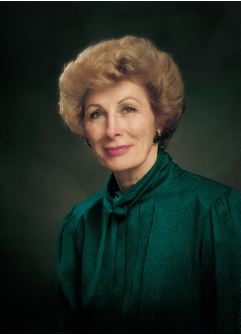 Born in Cardston, Alberta, Elaine Jack served for seven years (1990-97) as Relief Society General President. (Busath.com)
Born in Cardston, Alberta, Elaine Jack served for seven years (1990-97) as Relief Society General President. (Busath.com)
So what is the current state of affairs of the Church in southern Alberta? Stake presidents in southern Alberta, interviewed in 2014 and 2015, reported that the future looked promising. Without exception, leaders commended the Saints for their faithfulness in the payment of their tithes and offerings. Attendance remained consistently high, and support for the missionary programs of the Church was exceptional. Young men and women were entering the mission field in record numbers, especially after the lowering of the missionary age in 2012, and the number of senior couples serving missions had also increased. Priesthood and auxiliary leaders were reaching out to the less active, with many positive results.[114]
 During the severe flooding in High River, Alberta, in June 2013, the stakes in southern Alberta organized cleanup and emergency relief efforts. Yellow “Helping Hands” vests were seen everywhere as volunteers Saints, including youth and young single adults, arrived by the busload to help the beleaguered community. As one grateful resident exclaimed, “Everyone in town is talking about the Mormons and what they are doing.” (Cory Bevans)
During the severe flooding in High River, Alberta, in June 2013, the stakes in southern Alberta organized cleanup and emergency relief efforts. Yellow “Helping Hands” vests were seen everywhere as volunteers Saints, including youth and young single adults, arrived by the busload to help the beleaguered community. As one grateful resident exclaimed, “Everyone in town is talking about the Mormons and what they are doing.” (Cory Bevans)
As the local Church population increased, the urban trend continued. Lethbridge, which started as a dependent branch of the Alberta Stake, had three stakes in 2015. Even more telling was the fact that Calgary and Edmonton, which had once been dependent branches of the southern Alberta stakes, had seven and four stakes respectively by the end of 2015, and each had a temple, bringing the total number of temples in Alberta to three. Of the twenty-three stakes in Alberta in 2015, seventeen were located in cities with a population of fifty-five thousand or more.[115] In southern Alberta specifically, the majority of the stakes were located in communities that were exhibiting steady growth.
President Richard Low of the Lethbridge Alberta West Stake indicated that unprecedented growth had occurred in West Lethbridge, with new housing and commercial developments, as well as an increasing student and young married population. He envisioned the day when a second stake would be needed in West Lethbridge.[116]
The Lethbridge Stake, geographically speaking, was in 2015 the smallest in Canada, and, according to Cameron MacLennan, the stake president, this presented some unique demographics. There was a high single adult population because of the college and university, and there was also a high aging population, with a significant gap of those between the ages of thirty-five and fifty-five. Still, the stake had a 40 percent activity rate, based on sacrament meeting attendance, and missionary work was ongoing and consistent.[117]
David Stewart, president of the Lethbridge East Stake, reported that his stake, like most of the stakes in southern Alberta, had been affected by the recent downturn in the economy, particularly with dropping oil prices. However, efforts are being made through Church-based programs to assist those who are unemployed or underemployed.[118]
Dale Salmon, president of the Medicine Hat Alberta Stake, noted that convert baptisms were increasing in his stake, and that, because of increasing work and business opportunities, the move-out rate of Church members had slowed considerably. Many second-generation families are in the area, raising their families and strengthening the Church. The seminary and institute programs were strong and successful, and the Church was becoming better known among the area residents, the majority of whom are not members of the Church.[119]
Carlos Jensen, president of the Raymond Alberta Stake, and Jamie McMahon, president of the Magrath Alberta Stake, both reported on the growth of their stakes, as more families chose to live in smaller towns and commute to Lethbridge, and on the success of youth programs, such as family history and temple work activities and youth treks.[120]
The Cardston and Cardston West Stakes had many multigenerational families living within their boundaries, which provided a firm spiritual base. The two stakes, with seventeen Church units between them, were providing a high number of temple workers. Brian Low, president of the Cardston Alberta West Stake, indicates that his stake had over four hundred workers serving in the temple, which added an enviable strength to the stake and facilitated missionary work and growth.[121]
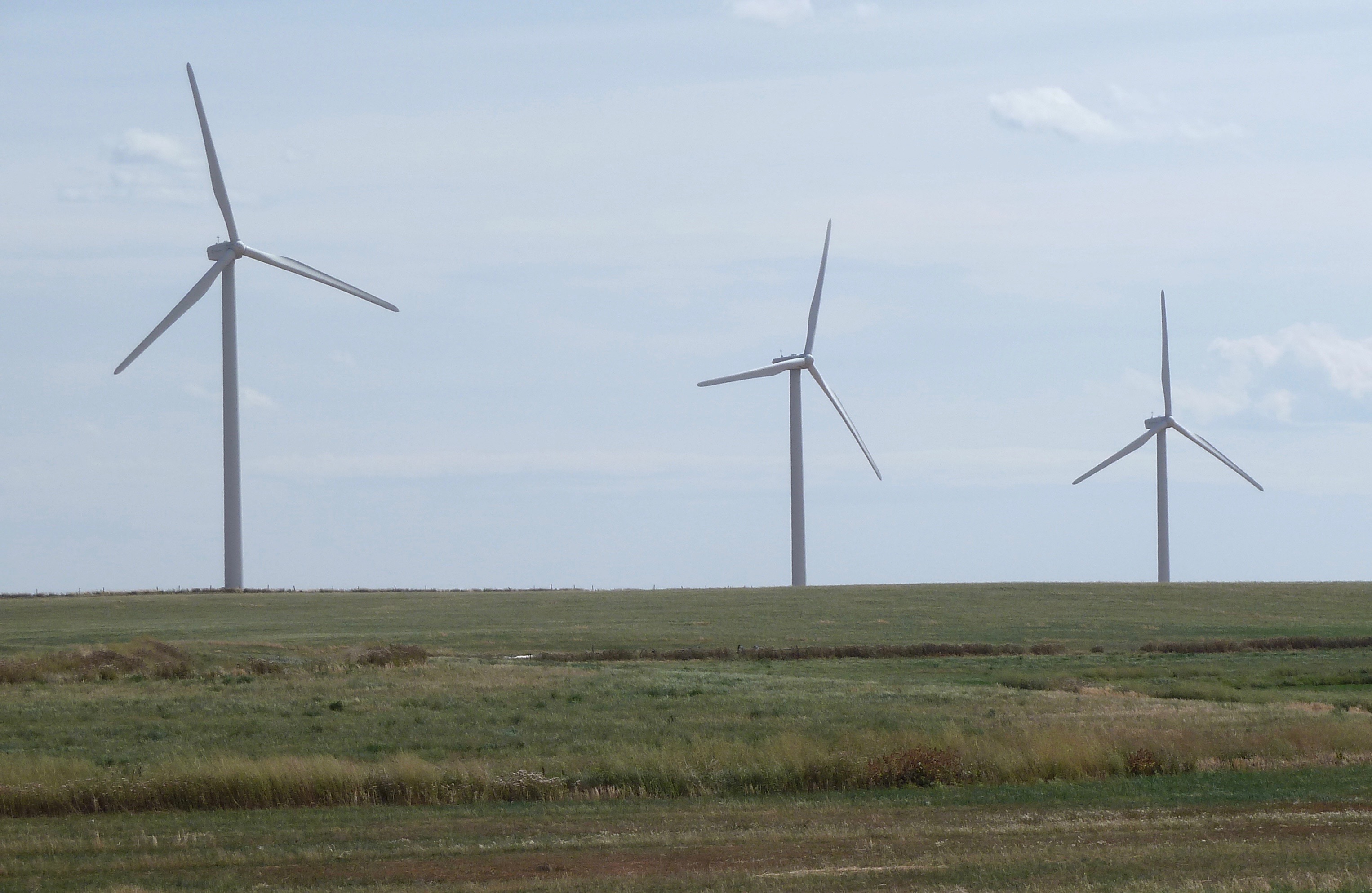 Those who drive the road between Lethbridge and Cardston will be impressed with the vast number of wind turbines near Magrath. The agricultural economy has also changed, in that pivot irrigation systems, as the one shown here near Taber, have nearly replaced flood irrigation in those areas under irrigation. (Darrel Nelson)
Those who drive the road between Lethbridge and Cardston will be impressed with the vast number of wind turbines near Magrath. The agricultural economy has also changed, in that pivot irrigation systems, as the one shown here near Taber, have nearly replaced flood irrigation in those areas under irrigation. (Darrel Nelson)
A challenge still facing some of the stakes with an agriculture-based economy is the changing dynamics in population. President Alan Poytress of the Fort Macleod Alberta Stake indicated that sons were no longer following in their fathers’ footsteps by staying on the family farms. They were seeking other careers, and young families were moving to larger centres. The stake was feeling the impact but was actively maintaining its focus on reactivation and hastening the work.[122] The situation was similar in the Taber Stake. President Mark Baldry indicated that as family farms became larger, younger families were moving away to find employment. However, some professionals, such as doctors and teachers, had moved into the stake. The multigenerational families who remained in the area were strong in the gospel and contributed to ongoing missionary efforts.[123]
 Train station in Stirling. Canada’s Mormon Trail begins in Cardston and ends in Stirling. It includes several national and provincial historic sites and has many points of interest that represent the cultural heritage the Saints have had in settling southern Alberta. (Darrel Nelson)
Train station in Stirling. Canada’s Mormon Trail begins in Cardston and ends in Stirling. It includes several national and provincial historic sites and has many points of interest that represent the cultural heritage the Saints have had in settling southern Alberta. (Darrel Nelson)
Although attendance at the Cardston Alberta Temple dropped in 2012 with the completion of the Calgary Alberta Temple, attendance has continued to grow as members across southern Alberta have increasingly looked to the temple as the great symbol of their Church membership.[124] They have also become increasingly involved in family history research, and they desire to take family names to the temple to do the work for their kindred dead.[125] All of the above indicators show that despite challenges unique to their circumstances, the southern Alberta stakes have remained strong and vibrant.
Conclusions
The entire story of the Church in southern Alberta is that of faithful members who are deeply rooted in their testimonies and in their loyalty to the Church. The temple has been the focus of their spiritual life and the symbol of their commitment to the gospel of Jesus Christ. While economic times have fluctuated and the population has shifted from rural to urban areas, southern Alberta has not only been “the seedbed” for the growth of the Church in Canada but has also provided a rich harvest of Church and civic leaders. The strength of the southern Alberta Saints attests to the blessings that have come from having a temple in their midst—blessings that have created the “strong multigenerational church communities” which then-Elder Henry B. Eyring lauded when he visited the Raymond Stake in October 2000. The powerful influence of the temple and the close integration of faith, family, and community, noted by Ardeth G. Kapp in her discussion of growing up in Glenwood, have been vital in helping southern Alberta LDS communities fulfill their ongoing mission.
Notes
[1] For the purposes of this chapter, the term “southern Alberta” is used in reference to communities south of Calgary.
[2] V. A. Wood, The Alberta Temple: Centre and Symbol of Faith (Calgary: Detselig Enterprises, 1989), 104.
[3] Terrence C. Smith, president of the Raymond Alberta Stake, 1997–2001, unpublished article, in possession of Darrel Nelson.
[4] For additional information on the Mormons and irrigation in southern Alberta, see James G. MacGregor, A History of Alberta (Edmonton: Hurtig Publishers, 1977), 165; Brigham Y. Card, “Charles Ora Card and the Founding of the Mormon Settlements . . .,” in Brigham Y. Card, and others, eds., The Mormon Presence in Canada (Edmonton: University of Alberta Press, 1990), 93–97; John Gilpin, Quenching the Prairie Thirst (Altona, Manitoba: Friesens Corporation, 2000), 8.
[5] “Irrigation in Alberta,” accessed 20 August 2016, www1.agric.gov.ab.ca/$department/
[6] Raymond Remembered: Settlers, Sugar and Stampedes (Raymond, Alberta: Town of Raymond, 1993), 5–52; Power of the Dream, 22–27, 101–6, 157, 168–70.
[7] Gilpin, Quenching the Prairie Thirst, vii.
[8] Raymond Remembered, 5–52; Power of the Dream, 22–27, 101–6, 157, 168–70.
[9] Barbara Grinder and others, Irrigation in Alberta (Lethbridge: Technology and Innovation Branch of Alberta Agriculture and Food, [2013?]), 5.
[10] Lethbridge Stake, A History of the Mormon Church in Canada (Lethbridge: The Lethbridge Herald, 1968), 86, 90, 108, 122–24, 141.
[11] Lethbridge Stake, Mormon Church in Canada, 103–4.
[12] Vern Orr and Seth Toone, interviewed by Darrel Nelson on 14 and 17 May 2014, respectively. Both Orr and Toone were in attendance at the meeting.
[13] Lethbridge Stake, Mormon Church in Canada, 77–91.
[14] Wood, Alberta Temple, 20.
[15] F. J. Jankunis, “Urban Development in Southern Alberta,” in F. J. Jankunis and others, eds., Southern Alberta: A Regional Perspective (Lethbridge: University of Lethbridge, 1972), 75.
[16] Power of the Dream, 150–52, 156, 164, 177–90.
[17] “Lethbridge,” Historica Canada, accessed 9 May 2016, http://
[18] Wood, Alberta Temple, 20.
[19] Byron C. Palmer and Craig J. Palmer, “Mormons in Western Canadian Agriculture. . . ,” in Card and others, eds., Mormon Presence in Canada, 239–40. See also Melvin S. Tagg, The Life of Edward James Wood: Church Patriot (master’s thesis, Brigham Young University, 1959); Olive Wood Nielson, A Treasury of Edward J. Wood (Salt Lake City: Publishers Press, 1983).
[20] L. Brent Goates, Harold B. Lee—Prophet and Seer (Salt Lake City: Bookcraft, 1985), 140.
[21] Lethbridge Stake, Mormon Church in Canada, 147.
[22] Lethbridge Stake, Mormon Church in Canada, 147–48.
[23] John R. Hicken, Deseret Ranches of Alberta: A Mormon Story Which Continues, 22–23.
[24] Nielson, Treasury of Edward J. Wood, 612–13.
[25] Wood, Alberta Temple, 119.
[26] Wood, Alberta Temple, 119–20.
[27] Ardis E. Parshall, “Lethbridge Alberta: ‘Ye Shall Obtain Riches…to Feed the Hungry,’” The Keepapitchinin—A semi-occasional paper, 25 February 2010, www.keepapitchinin.org/?s=Lethbridge&submit=Search; Carol Cornwall Madsen, “The Christian Way,” Church News, 1 July 1978, 16.
[28] Frankburg Ward manuscript history and historical reports, 1929–1937, Church History Library, Salt Lake City (hereafter CHL), LR 2983 2; Lethbridge Stake, Mormon Church in Canada, 134–35, 147–48.
[29] Lethbridge Stake, Mormon Church in Canada, 148.
[30] Card and others, eds., Mormon Presence in Canada, 231.
[31] Reed Turner, Terrence C. Smith, and others, eds., A Planting of the Lord: A Century of the Latter-day Saints in Raymond, 1901–2001 (Raymond: Raymond Alberta Stake, 2001), 458.
[32] Don Petrak, “Thank You, Raymond, For a Christmas Miracle,” in Turner, Smith, and others, eds., Planting of the Lord, 242–43.
[33] MacGregor, History of Alberta, 262–65.
[34] Palmer and Palmer, “Mormons in Western Canadian Agriculture,” 244–47.
[35] Palmer and Palmer, “Mormons in Western Canadian Agriculture,” 247.
[36] Lethbridge Stake, Mormon Church in Canada, 149.
[37] Evelyn Hendry and others, Veterans’ Voices (Raymond: Raymond & District Historical Society, 2001), 85.
[38] Hendry and others, Veterans’ Voices, 36.
[39] Hendry and others, Veterans’ Voices, 109.
[40] Owen “Brownie” Witbeck, interview with Darrel Nelson, 26 October 2013, Raymond, Alberta.
[41] Norma Smith and others, While You Were Away 1939–1945 (Raymond: Raymond & District Historical Society, 2004), 32.
[42] Smith and others, While You Were Away, 36.
[43] Lethbridge Stake, Mormon Church in Canada, 149.
[44] Merlin R. Lybbert, Trials, Travels and Testimony: An Autobiography of Merlin R. Lybbert (Bountiful: Family History Publishers, 2000), 44.
[45] Smith and others, While You Were Away, 39.
[46] Hendry and others, Veterans’ Voices, 116.
[47] David B. Iwaasa, “The Mormons and Their Japanese Neighbours,” Alberta History, Winter 2005, 7.
[48] Iwaasa, “Mormons and Their Japanese Neighbours,” 16–17.
[49] Iwaasa, “Mormons and Their Japanese Neighbours,” 18–19.
[50] Iwaasa, “Mormons and Their Japanese Neighbours,” 20.
[51] Iwaasa, “Mormons and Their Japanese Neighbours,” 7.
[52] Iwaasa, “Mormons and Their Japanese Neighbours,” 20–21.
[53] Howard Palmer, “Patterns of Immigration and Ethnic Settlement in Alberta, 1880–1920,” in Howard Palmer and Tamara Jeppson Palmer, eds., Peoples of Alberta: Portraits of Cultural Diversity (Saskatoon: Western Producer Prairie Books, 1985), 7, 16–20, 26–27.
[54] Raymond Remembered, 300–1.
[55] Iwaasa, “Mormons and Their Japanese Neighbours,” 21.
[56] David Iwaasa, Church Directory of Organizations and Leaders (CDOL), last updated 30 July 2012, cdol.lds.org.
[57] Jankunis, “Urban Development in Southern Alberta,” in Jankunis and others, eds., Southern Alberta: A Regional Perspective, 80.
[58] Jankunis, “Urban Development in Southern Alberta,” 81; “Population Data 1941,” www.municipalaffairs.alberta.ca/
[59] Lethbridge Stake, Mormon Church in Canada, 79–82, 107–19, 129.
[60] Lethbridge Stake, Mormon Church in Canada, 82, 86–91.
[61] Lethbridge Stake, Mormon Church in Canada, 158.
[62] Lethbridge Stake, Mormon Church in Canada, 156–59.
[63] Lethbridge Stake, Mormon Church in Canada, 166.
[64] Wood, Alberta Temple, 128–29.
[65] Personal observations of the author.
[66] Wood, Alberta Temple, 140.
[67] “Wards and Branches in Southern Alberta (Canada),” consulted 24 August 2015, www.google.com/
[68] Betty Evans and others, “Raymond Reunited,” in Planting of the Lord, 123–25.
[69] Magrath Alberta Stake, associated organizations, CDOL, accessed 5 May 2016, cdol.lds.org.
[70] Cardston Alberta Stake, associated organizations, CDOL, accessed 5 May 2016, cdol.lds.org.
[71] Cardston Alberta West Stake, associated organizations, CDOL, accessed 5 May 2016, cdol.lds.org.
[72] Brian Low, interview with Darrel Nelson, 29 May 2014.
[73] Fort Macleod Alberta Stake, associated organizations and historical information, CDOL, cdol.lds.org.
[74] Alan Poytress, interview with Darrel Nelson, 29 May 2014; Park Lake Ward and Pincher Creek Ward, historical information, CDOL, cdol.lds.org.
[75] Dale Salmon, interview with Darrel Nelson, 25 August 2015; Medicine Hat Alberta Stake, associated organizations, CDOL, cdol.lds.org.
[76] Richard Low, interview with Darrel Nelson, 29 May 2014; Lethbridge Alberta West Stake, associated organizations, CDOL, cdol.lds.org.
[77] Smith, unpublished article.
[78] “Wards and Branches in Southern Alberta (Canada),” www.google.com/
[79] Card, “Charles Ora Card and Founding of the Mormon Settlements,” Card and others, eds., Mormon Presence in Canada, 80.
[80] Lethbridge Stake, Mormon Church in Canada, 93.
[81] See M. Dallas Burnett, “Lamanites and the Church,” Ensign, July 1971, 11–13.
[82] James B. Allen, “The Rise and Decline of the LDS Indian Student Placement Program, 1947–1996,” Mormons, Scripture, and the Ancient World: Studies in Honor of John L. Sorensen, ed. Davis Bitton (Provo: Foundation for Ancient Research and Mormon Studies, 1998), 85–119.
[83] Brent L. Lybbert, interview with Darrel Nelson, 29 September 2014.
[84] Brent L. Lybbert, interview.
[85] Sheri L. Dew, Go Forward With Faith: The Biography of Gordon B. Hinckley (Salt Lake City: Deseret Book, 1996). See photograph section between pages 366–67.
[86] Brent L. Lybbert, interview with Darrel Nelson, 29 September 2014.
[87] Personal experience of author.
[88] Cannon, “Alberta Temple ‘washed, polished,’” Church News, 29 June 1991, 3.
[89] Cannon, “Alberta Temple ‘washed, polished,’” 3.
[90] “President Hinckley observes his 81st birthday at dedication,” Church News, 29 June 1991.
[91] Rod Gustafson, “Sisters recall attending original, 1923 dedication,” Church News, 29 June 1991, 9.
[92] “Alberta Temple joins Canada’s historic buildings,” Westwind Community News, vol. 2, number 38, 19 September 1995.
[93] Howard W. Hunter, “The Great Symbol of Our Membership,” Ensign, October 1994, 2.
[94] “Choose Lethbridge,” “Demographics,” accessed 19 May 2016, chooselethbridge.ca/
[95] Brian Turner, “The Beginnings of Seminary in Western Canada,” O Canada: Where Stalwart Sons and Gentle Maidens Rise, June 2013, 8, 39, 42.
[96] Turner, O Canada: Where Stalwart Sons and Gentle Maidens Rise, 63, 66.
[97] "A Key to Europe: Young single adults are vital to the strength of the Church," Church News, 2 September 2006, 11.
[98] Lethbridge Alberta Stake, Lethbridge Alberta West Stake, Lethbridge Alberta East Stake, Cardston Alberta Stake, and Medicine Hat Alberta Stake, associated organizations, CDOL, accessed 6 May 2016, cdol.lds.org; author’s interviews with stake presidents, May–September 2014.
[99] Hicken, Deseret Ranches of Alberta: A Mormon Story Which Continues, 145.
[100] Gordon B. Hinckley, “The State of the Church,” Ensign, May 1991.
[101] Darren Bevans, interview with Darrel Nelson, 24 August 2015.
[102] Outline published by LDS Employment Services, Lethbridge Office in Lethbridge, Alberta, April 2014, in possession of Darrel Nelson.
[103] David Reeve, interview with Darrel Nelson, 16 June 2014.
[104] David K. Elton, “Political Behavior of Mormons in Canada,” in Card and others, Mormon Presence in Canada, 267–69.
[105] Elton, “Political Behavior,” in Card and others, Mormon Presence in Canada, 271–72.
[106] Elton, “Political Behavior,” Mormon Presence in Canada, 269–71; Ernest G. Mardon and Austin A. Mardon, Alberta Mormon Politicians (Edmonton, Alberta: Fisher House Publishers, 1992), 14.
[107] Wikipedia, s.vv. “Ady, Jack,” “Bikman, Gary,” “Hinman, Paul,” “Jacobs, Broyce”; Legislative Assembly of Alberta, Members of the Legislative Assembly, accessed 9 May 2016, www.assembly.ab.ca.
[108] Elton, “Political Behavior,” in Card and others, Mormon Presence in Canada, 267, 272.
[109] Grant Hill, interview with Darrel Nelson, 3 November 2014.
[110] Jim Hillyer, interview with Darrel Nelson, 17 October 2014; Ryan Maloney, “Jim Hillyer, Conservative MP, Dead at the Age of 41,” Huffington Post, 23 March 2016, huffingtonpost.ca/
[111] David K. Elton, “Political Behavior of Mormons,” in Mormon Presence in Canada, 275.
[112] Wood, Alberta Temple, 23, n. 29.
[113] List compiled by Elder Terrence Smith and Darrel Nelson.
[114] Based on the author’s interviews with the ten stake presidents in southern Alberta.
[115] Based on “List of Cities and Towns in Alberta” from the Alberta website. See https://
[116] Richard Low, interview with Darrel Nelson, 29 May 2014.
[117] Cameron D. MacLennan, interview with Darrel Nelson, 25 August 2015.
[118] David Stewart, interview with Darrel Nelson, 1 September 2015.
[119] Dale A. Salmon, interview with Darrel Nelson, 25 August 2015.
[120] Carlos L. Jensen, interview with Darrel Nelson, 2 May 2014; Jamie McMahon, interview with Darrel Nelson, 25 August 2015; Alan Dudley, interview with Darrel Nelson, 2 September 2015.
[121] Brian Low, interview with Darrel Nelson, 29 May 2014.
[122] Alan Poytress, interview with Darrel Nelson, 29 April 2014.
[123] Mark A. Baldry, interview with Darrel Nelson, 25 August 2015.
[124] L. Mark Evans, in a meeting where Darrel Nelson was present, April 2014.
[125] Statement of Darrel Nelson, 11 January 2017.
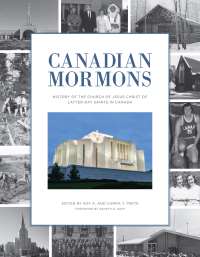
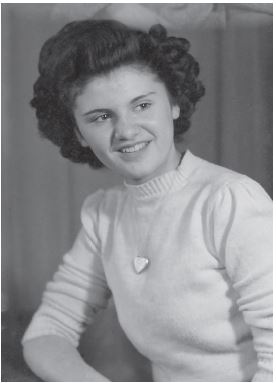 Ardeth Greene (Kapp), at age fifteen or sixteen. (Ardeth G. Kapp)
Ardeth Greene (Kapp), at age fifteen or sixteen. (Ardeth G. Kapp) Asael E. Palmer made a significent contribution to Canadian agriculture. (Galt Museum)
Asael E. Palmer made a significent contribution to Canadian agriculture. (Galt Museum)